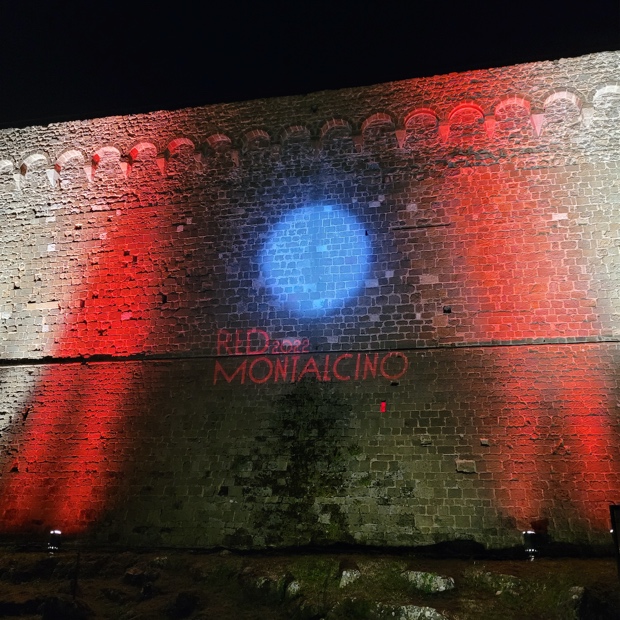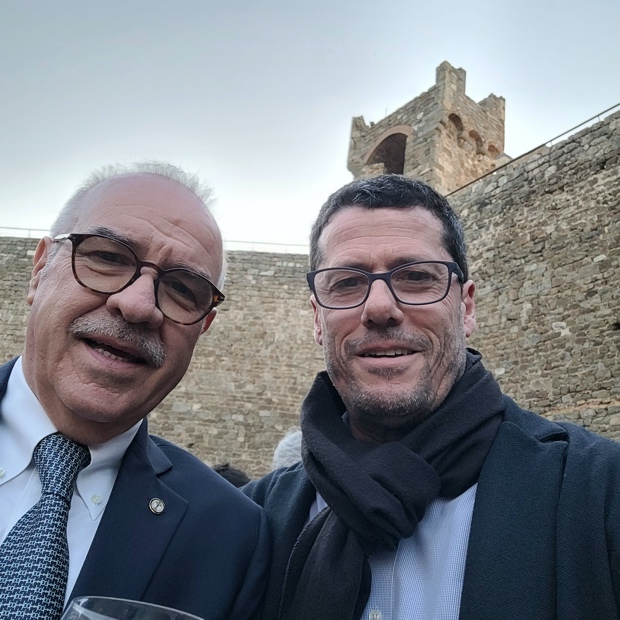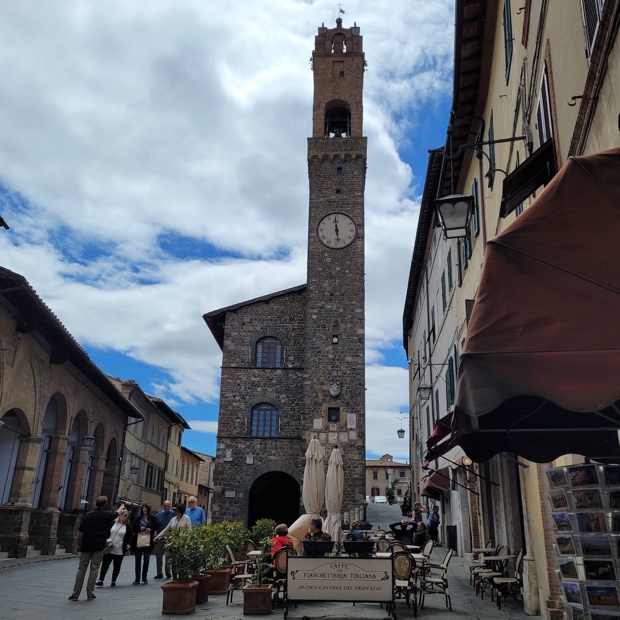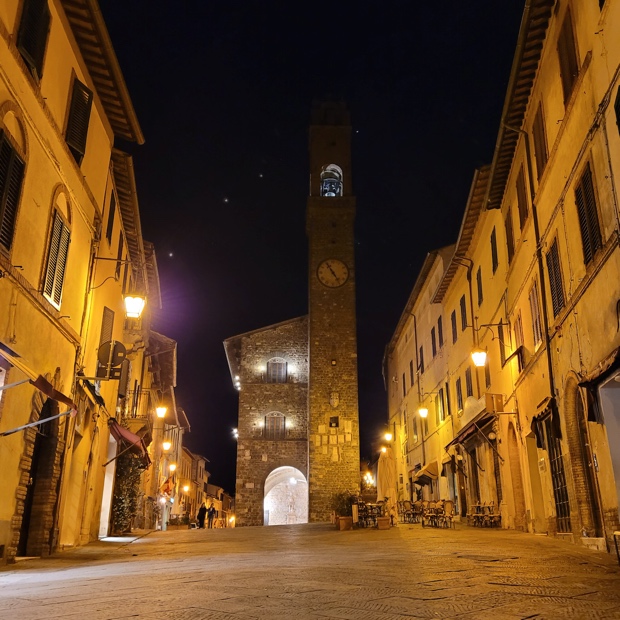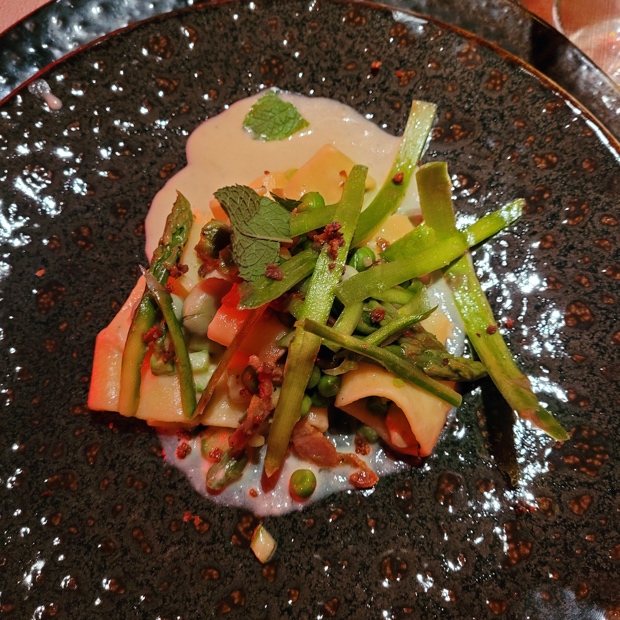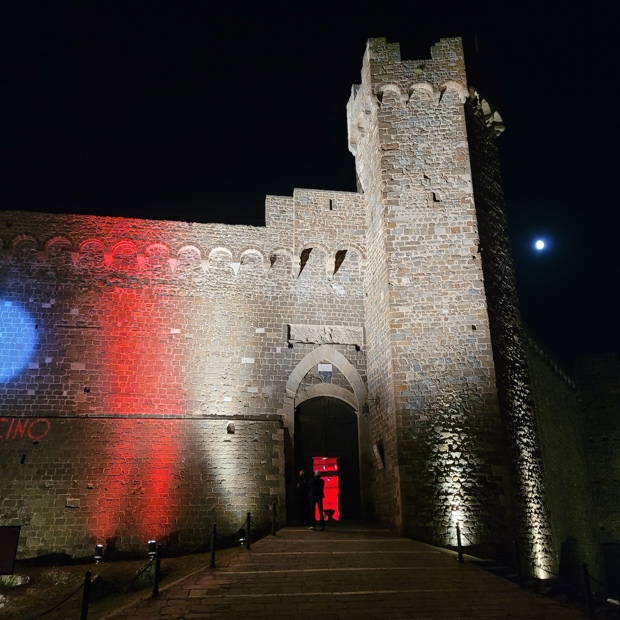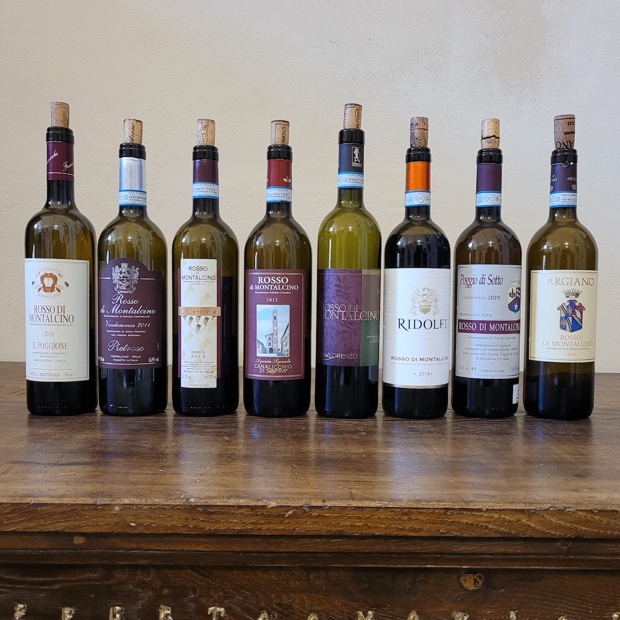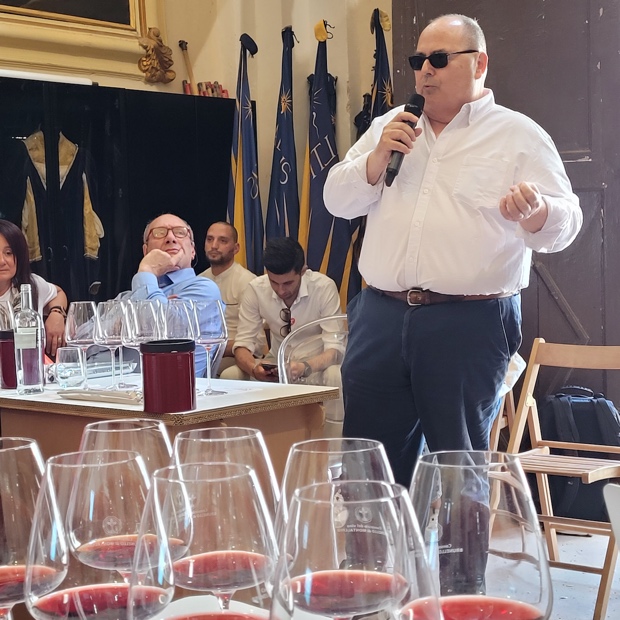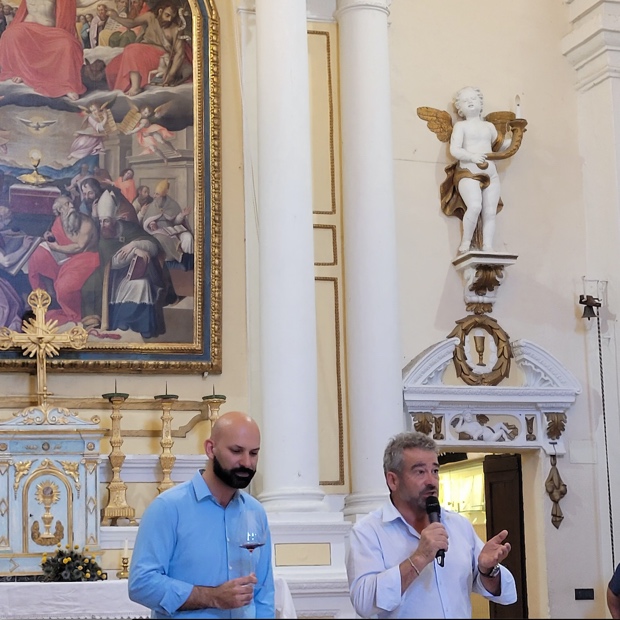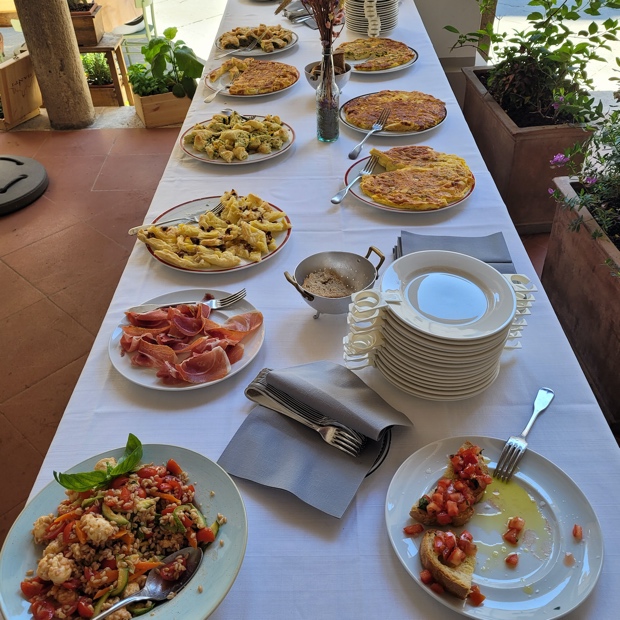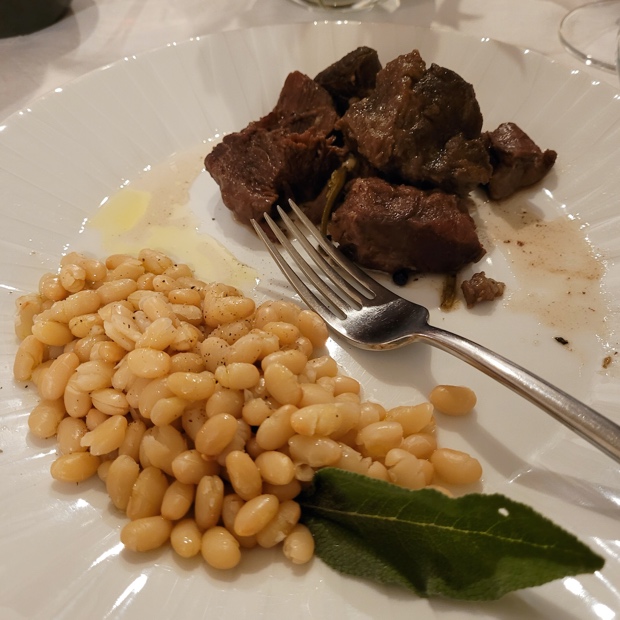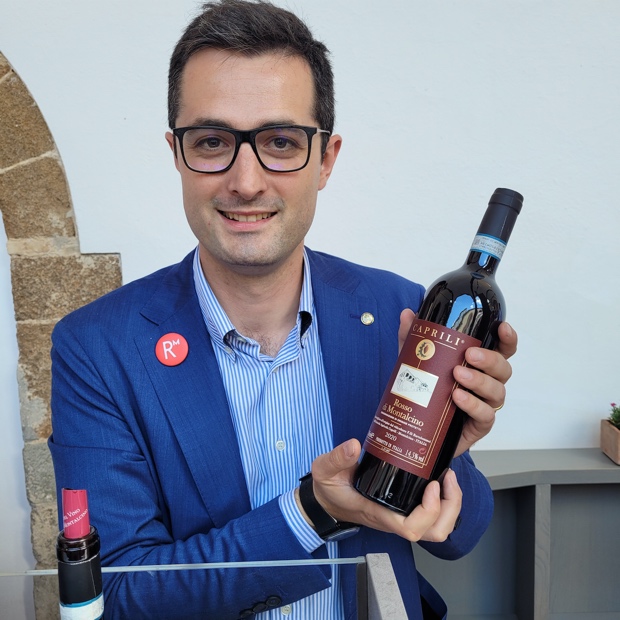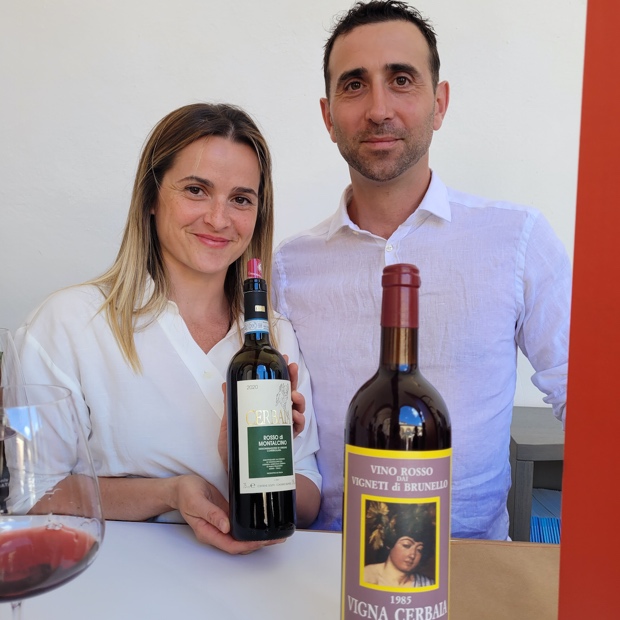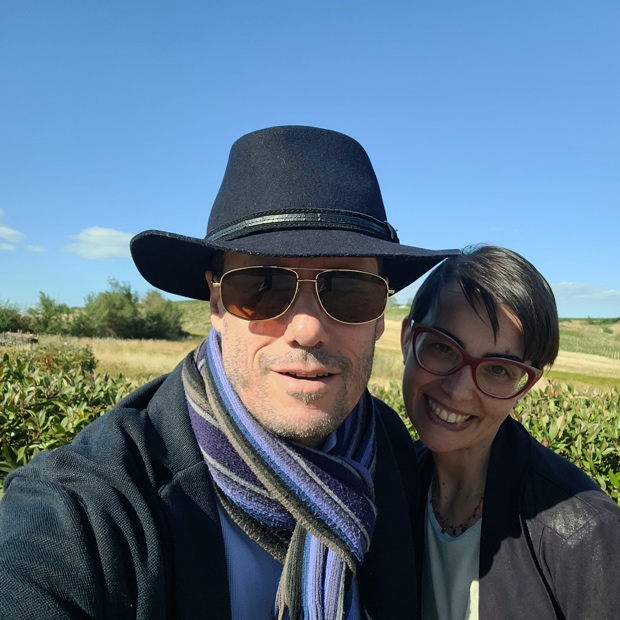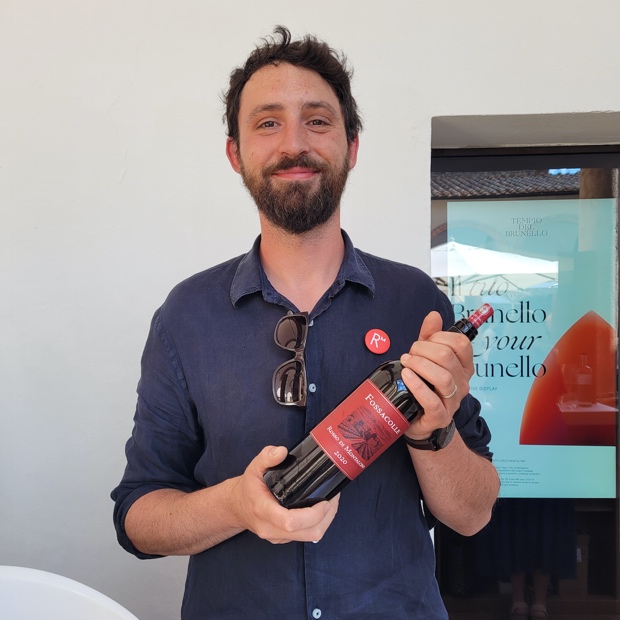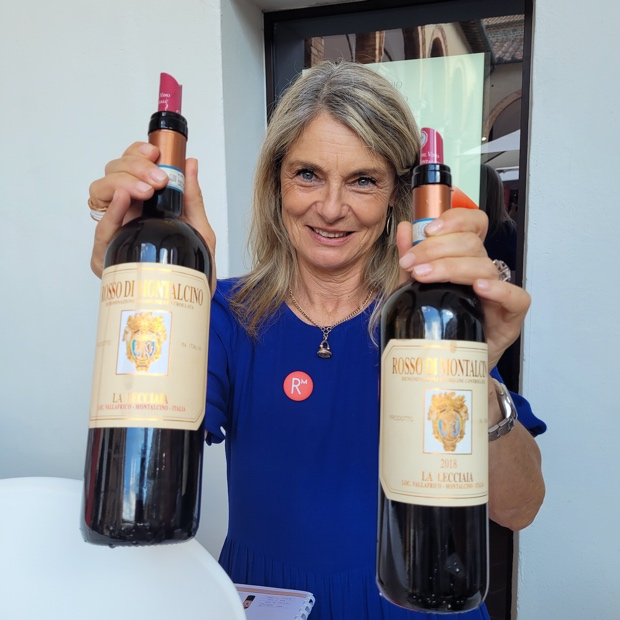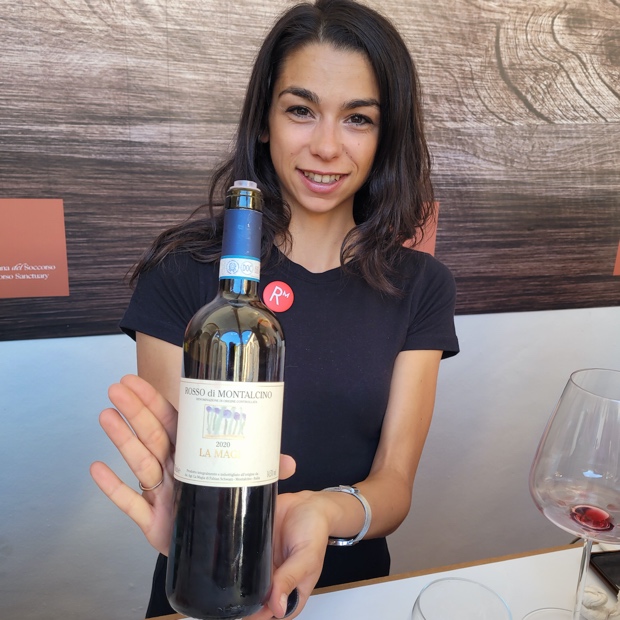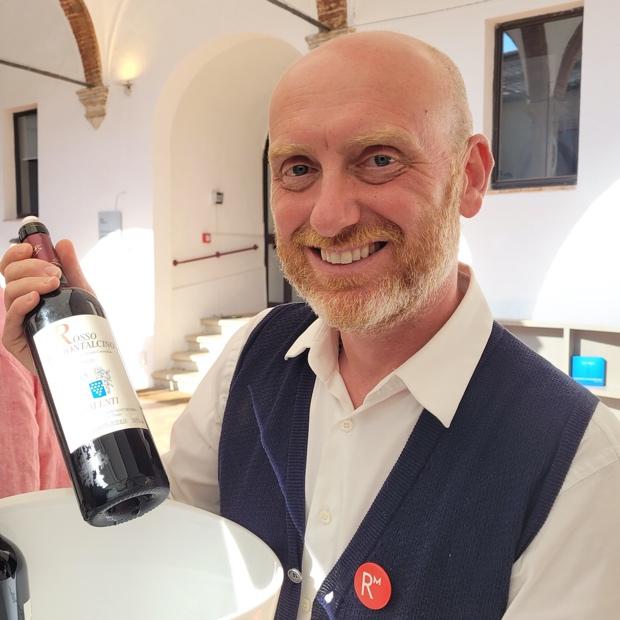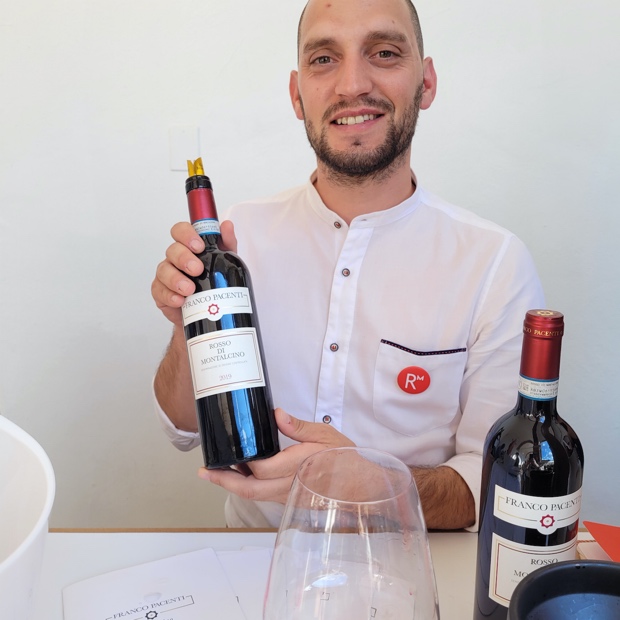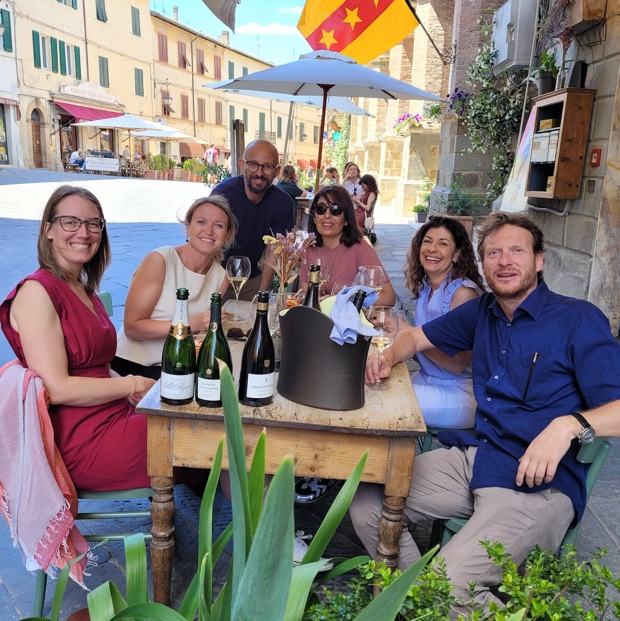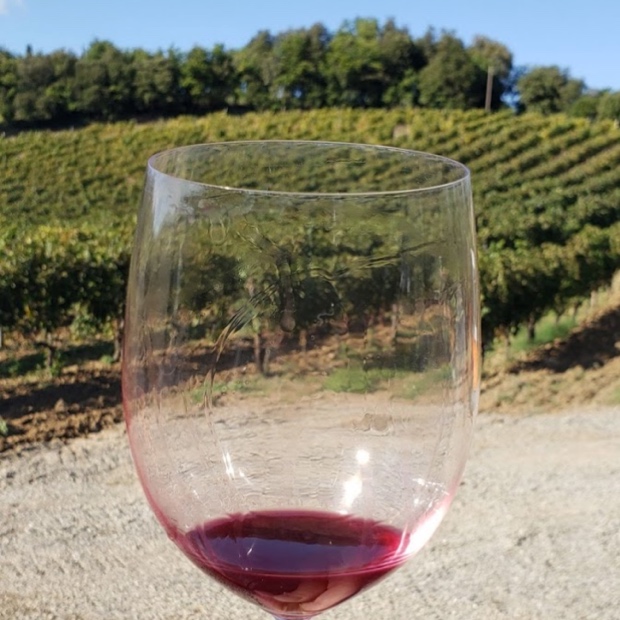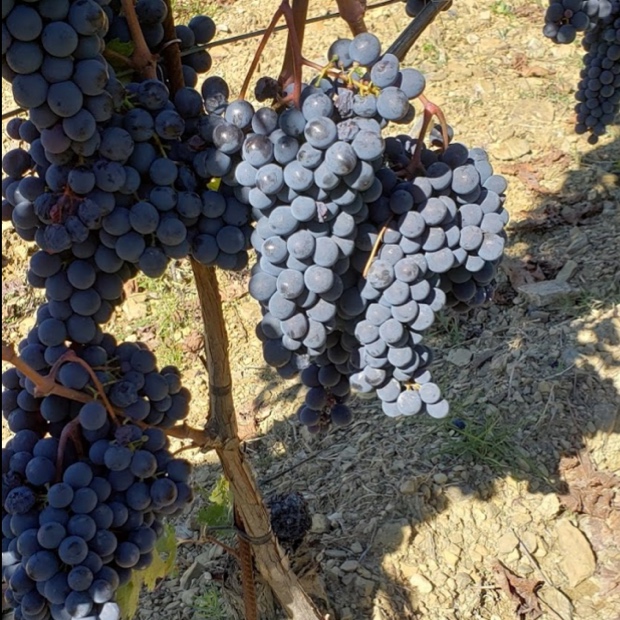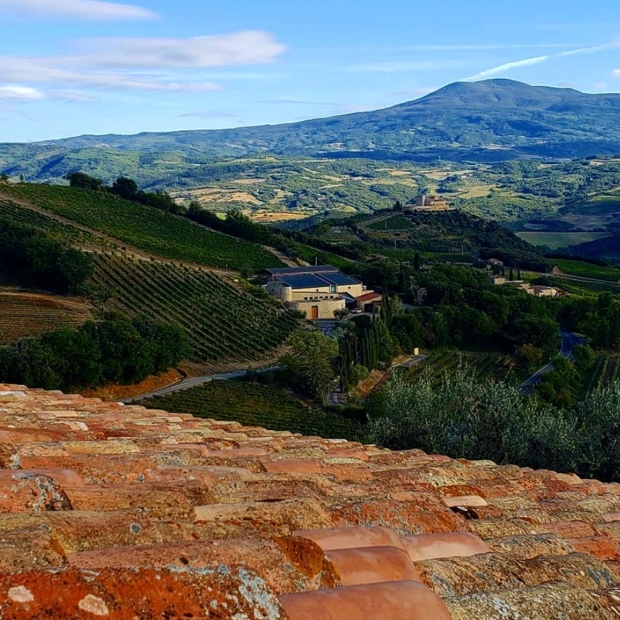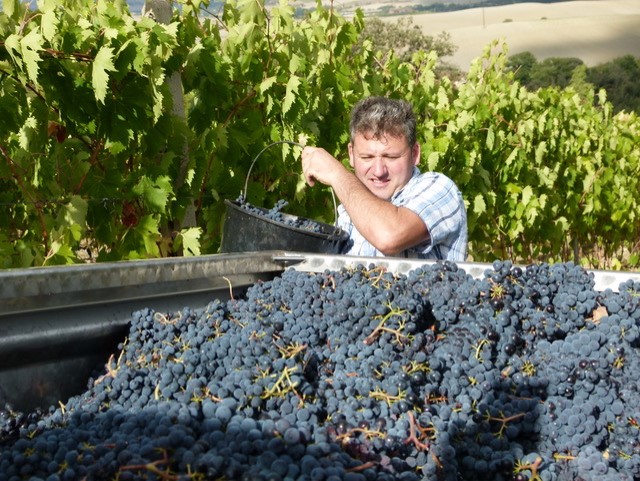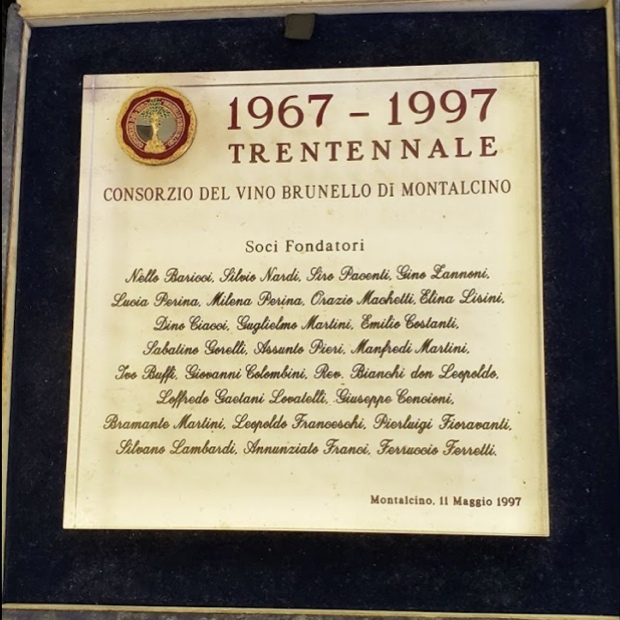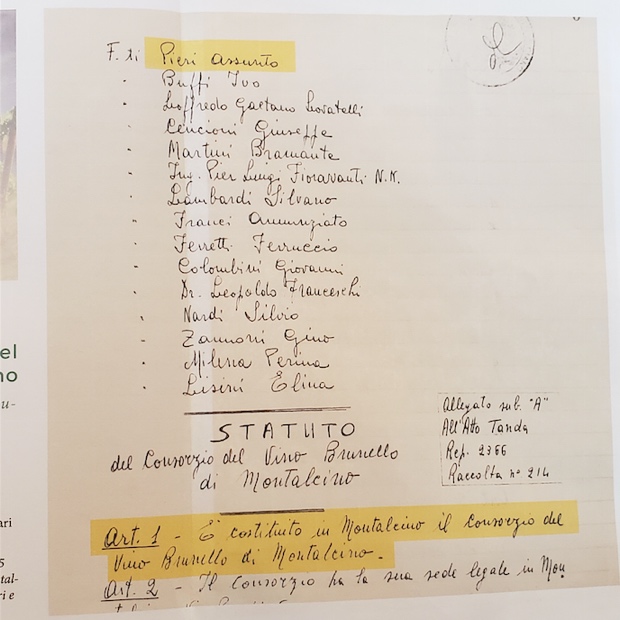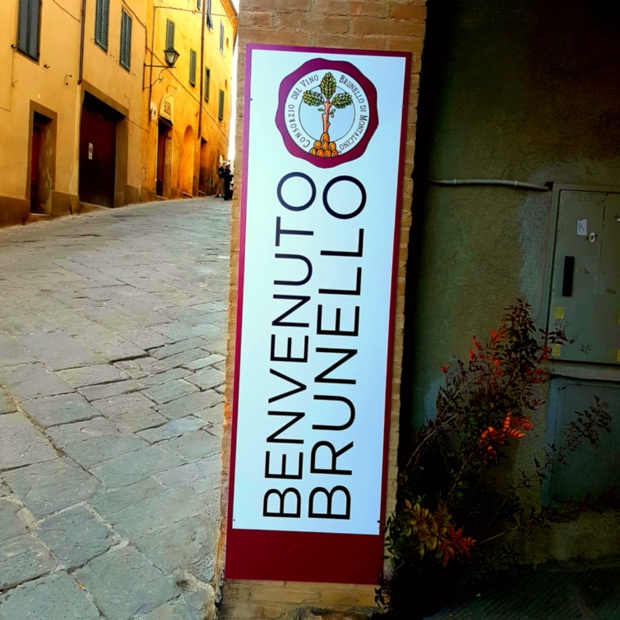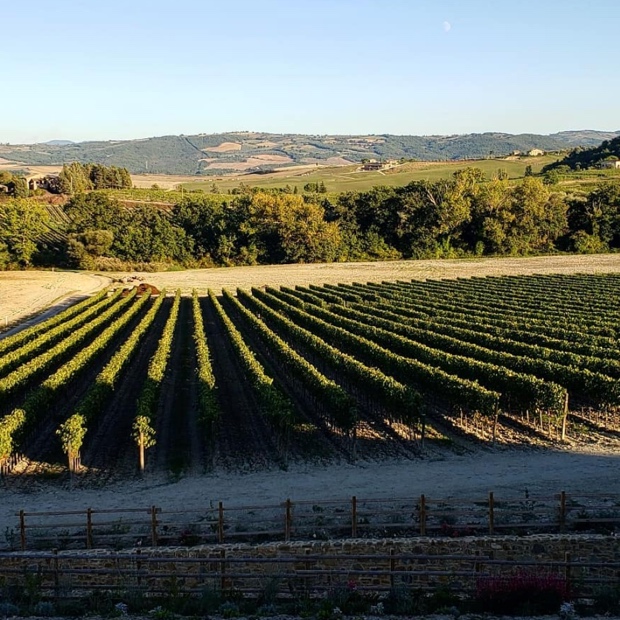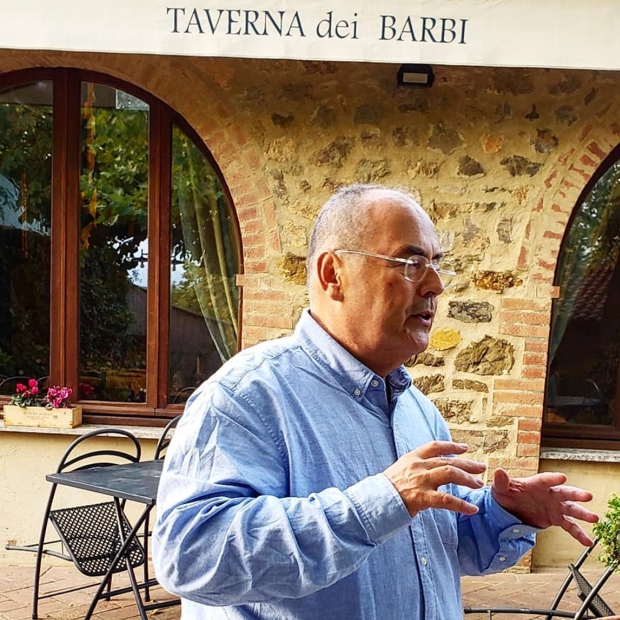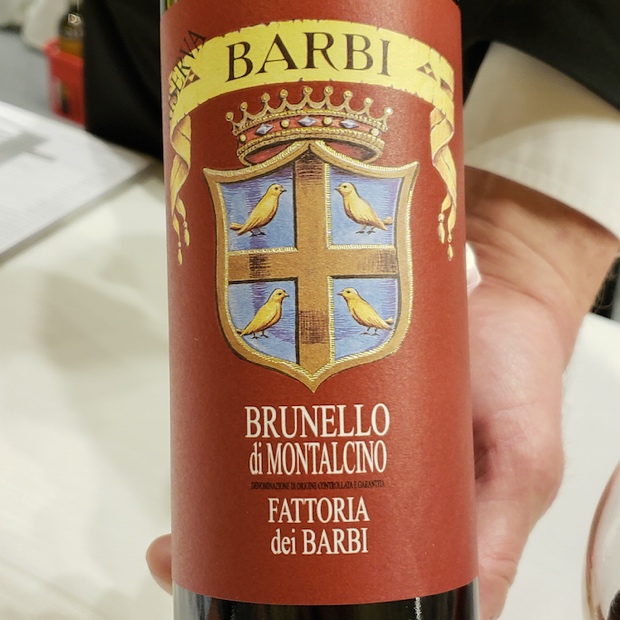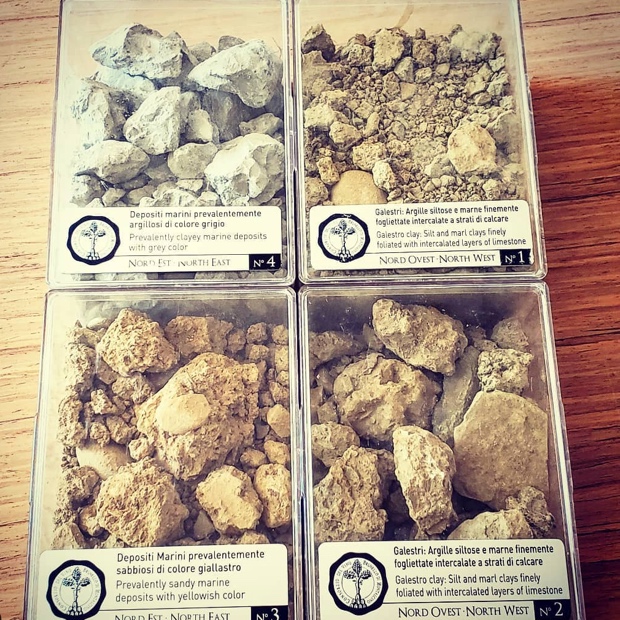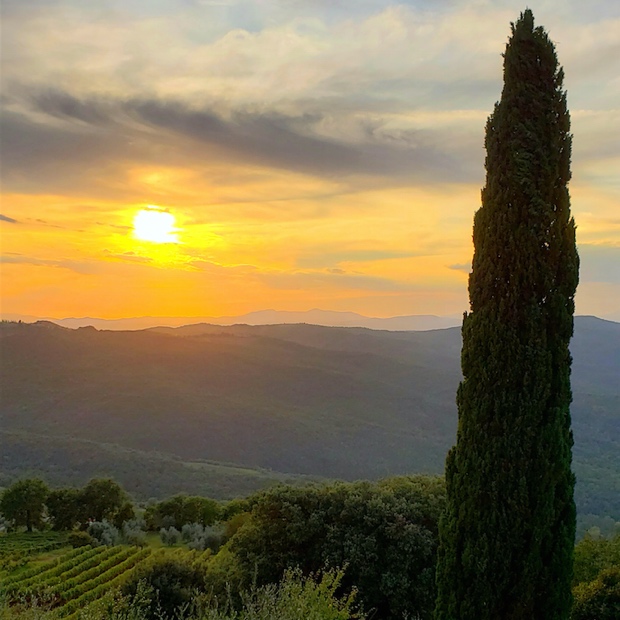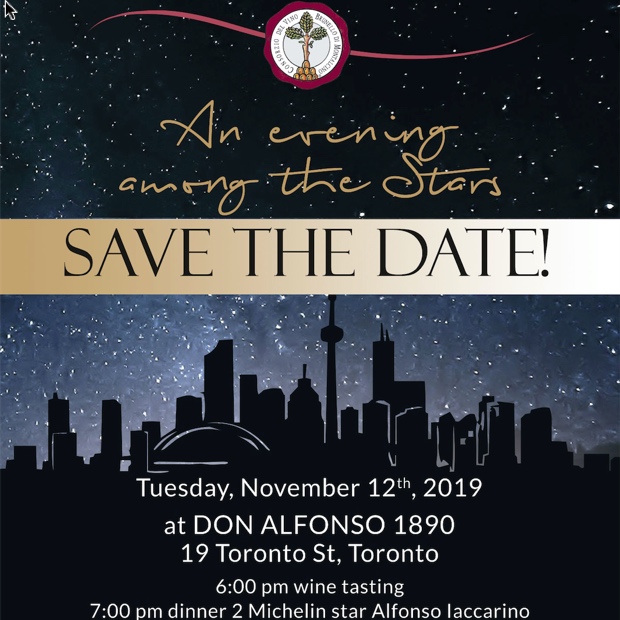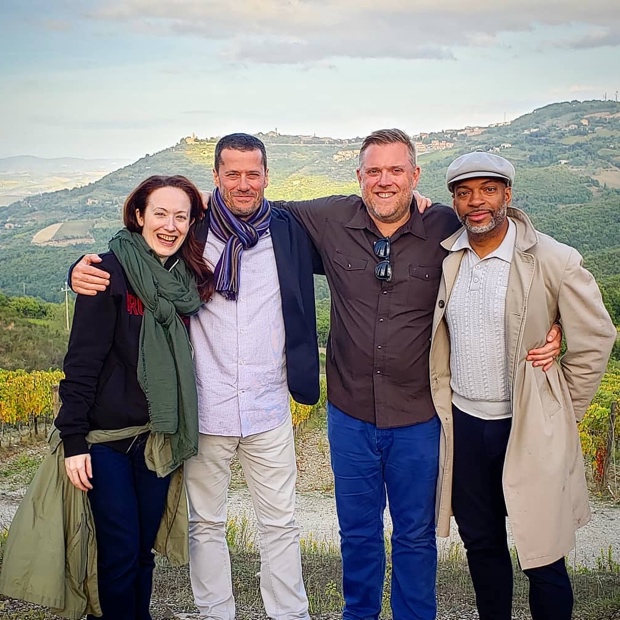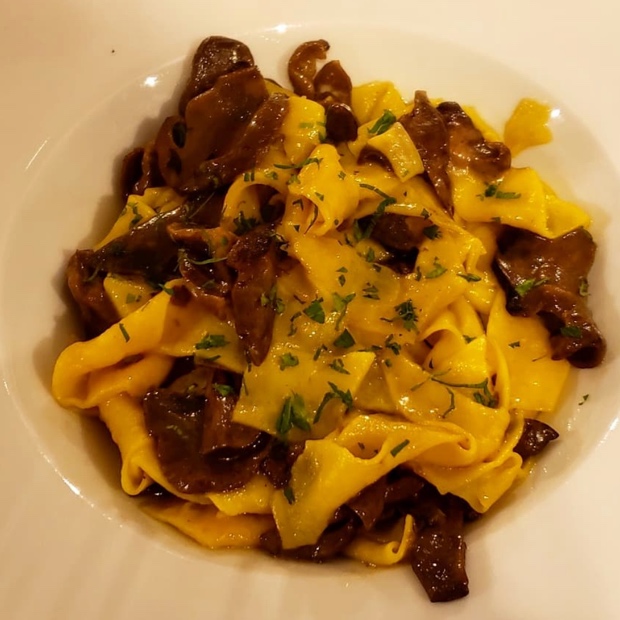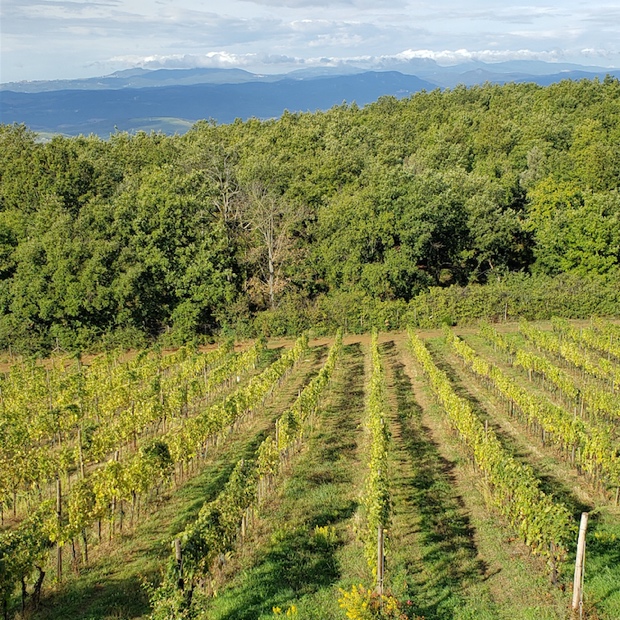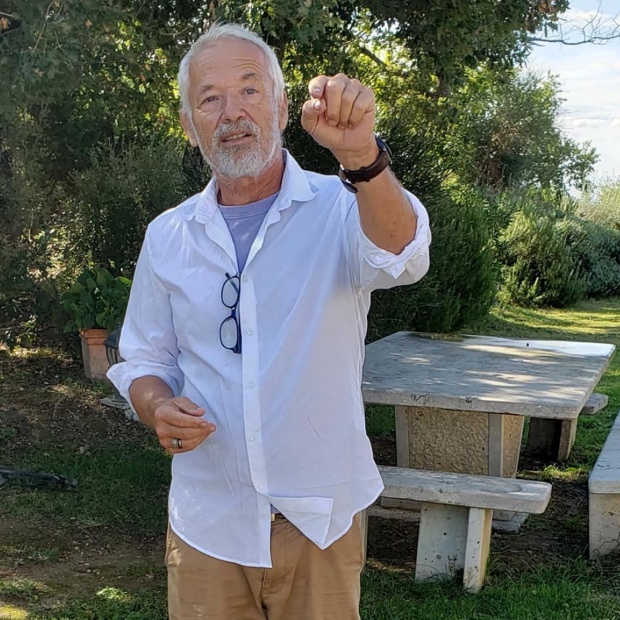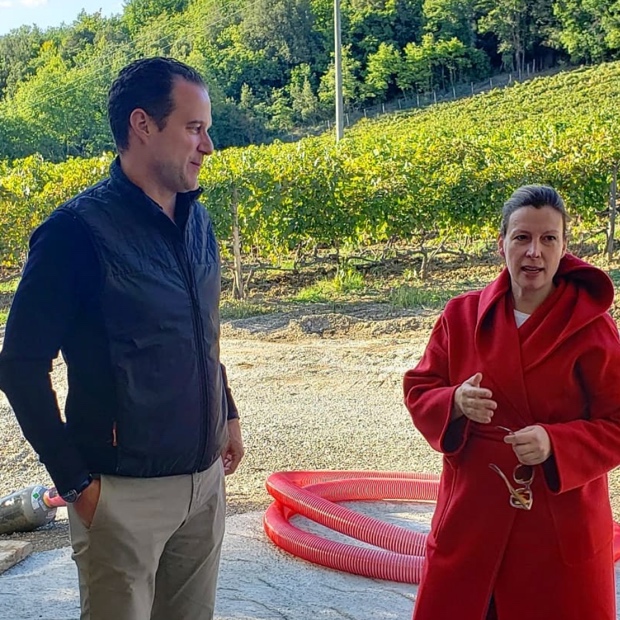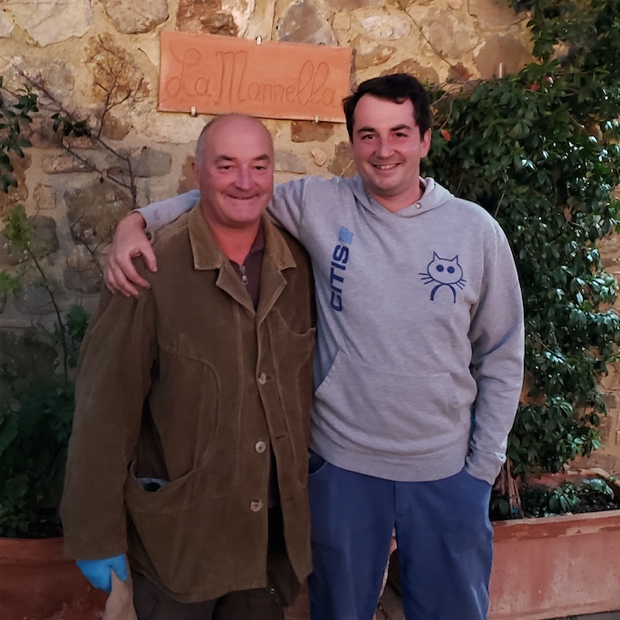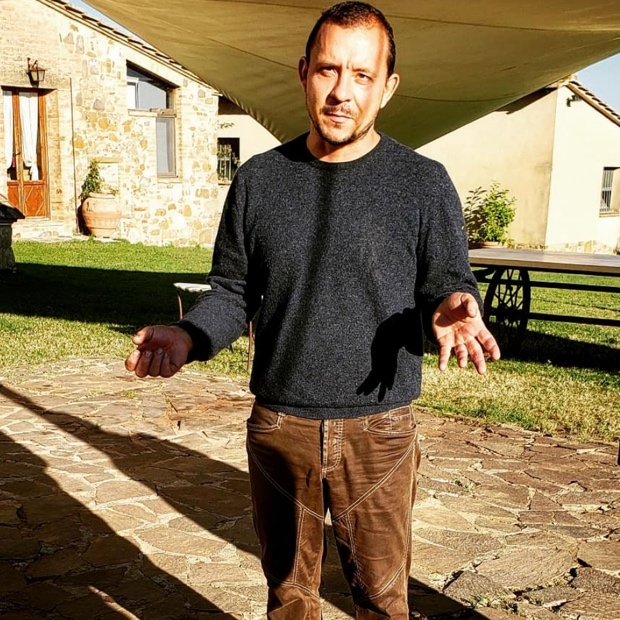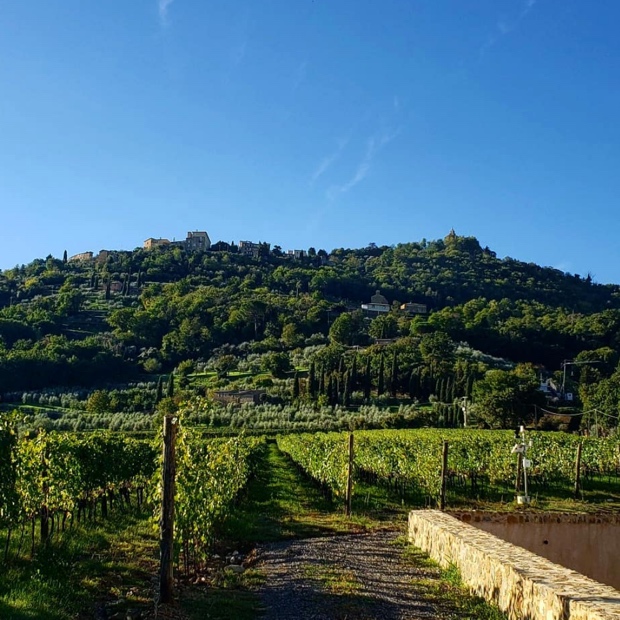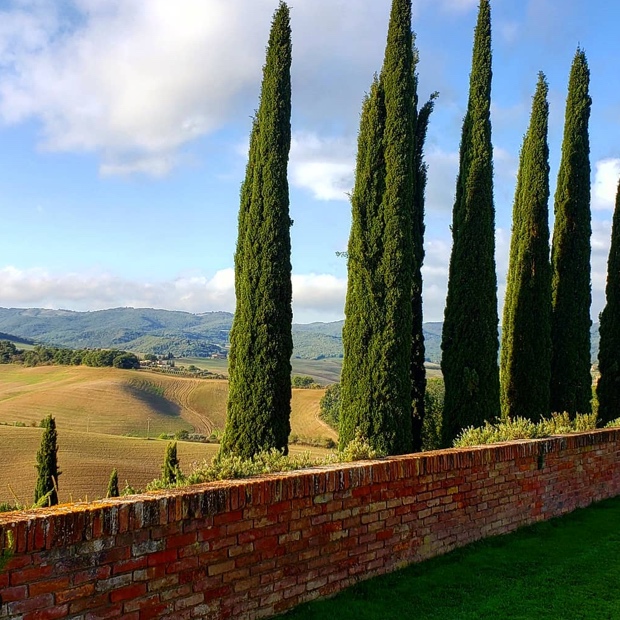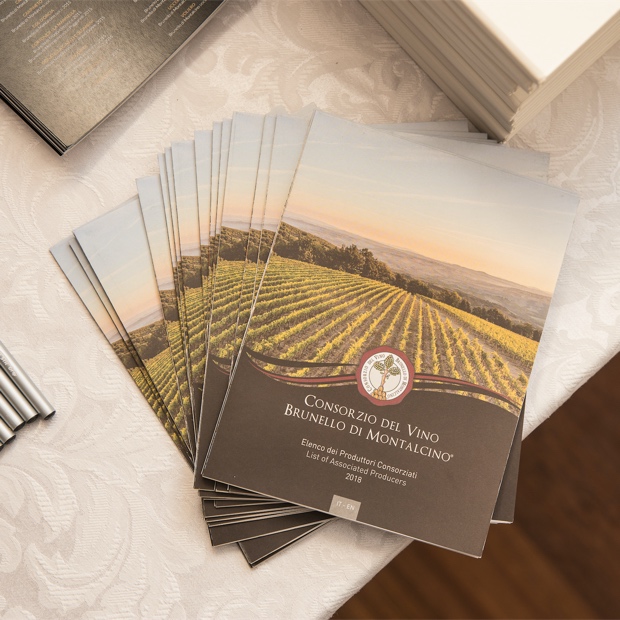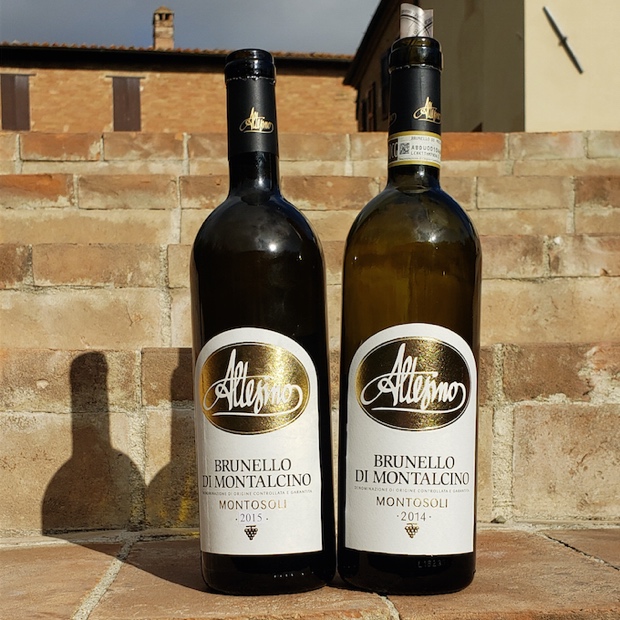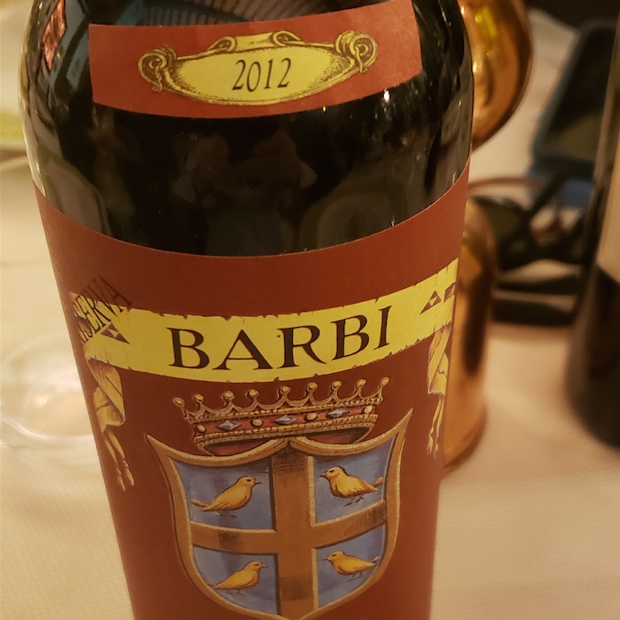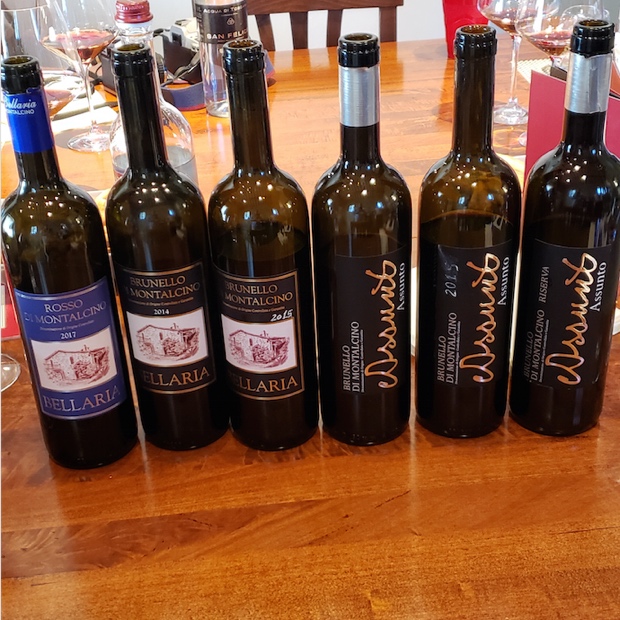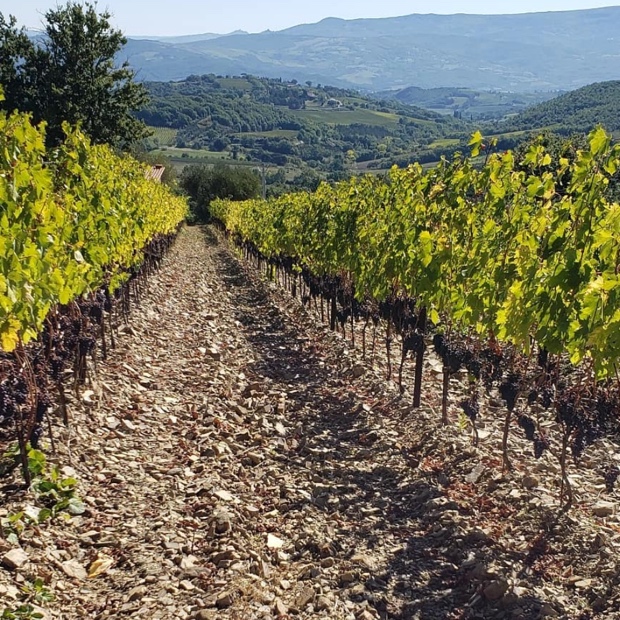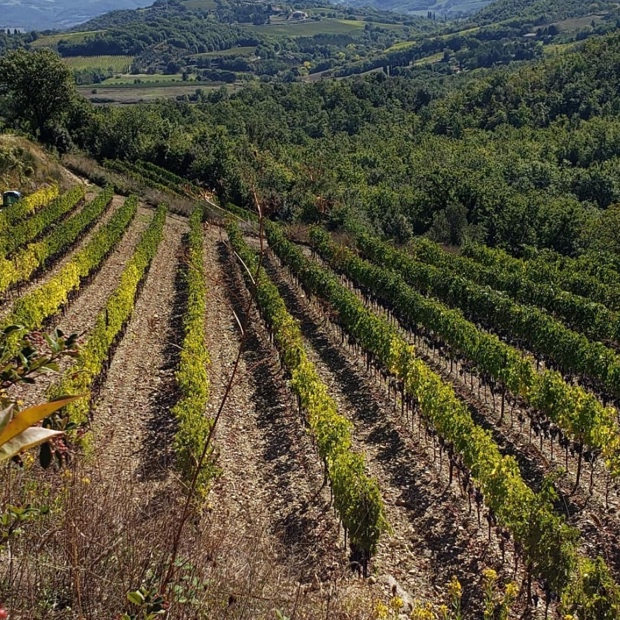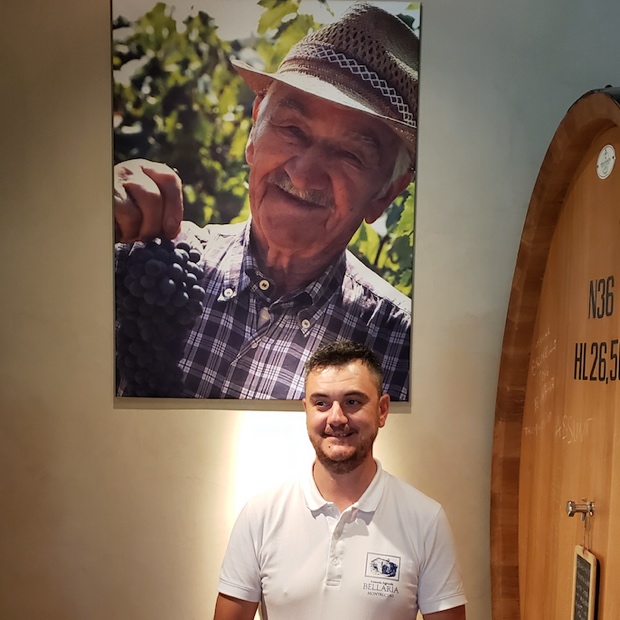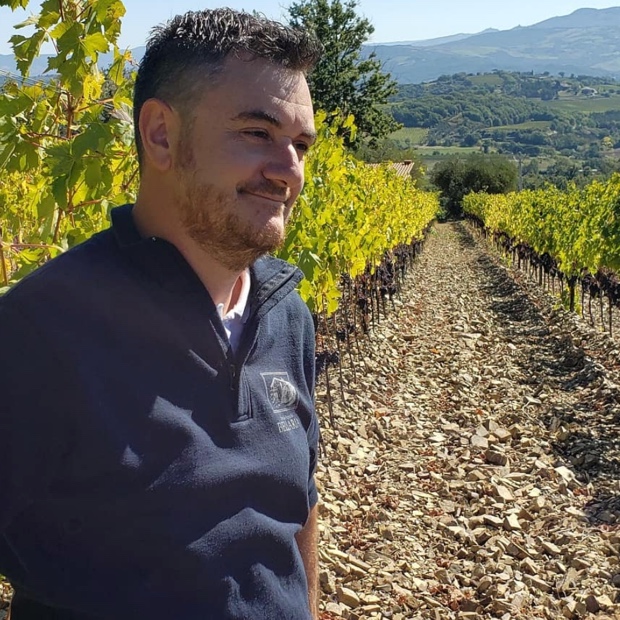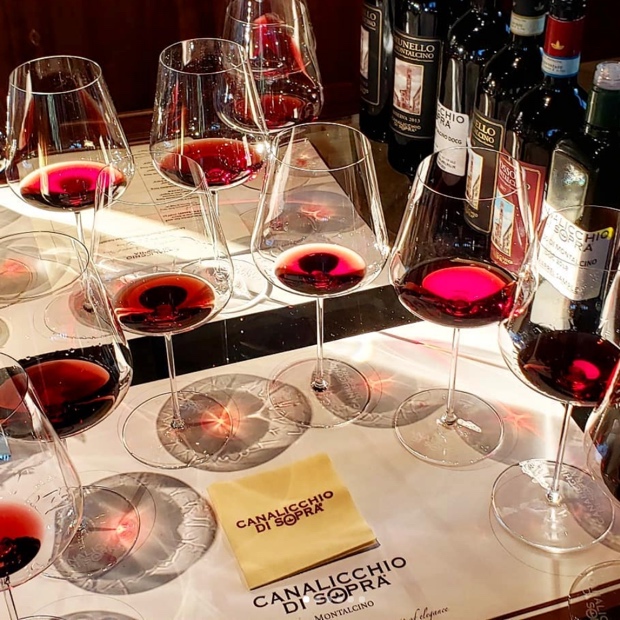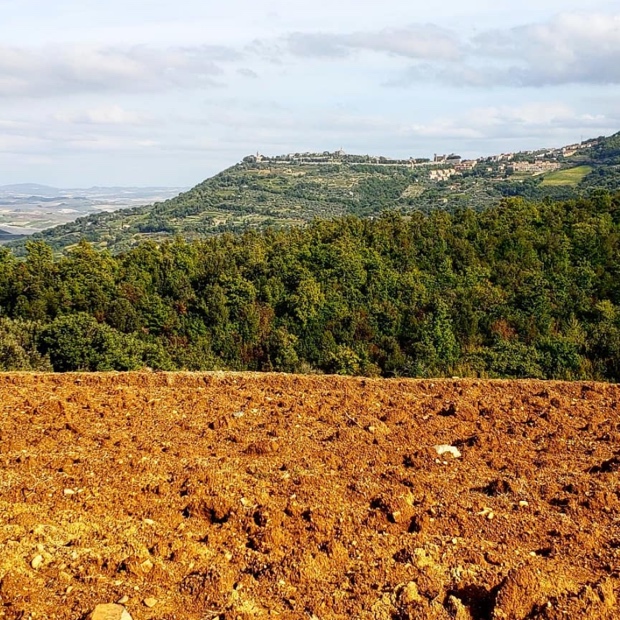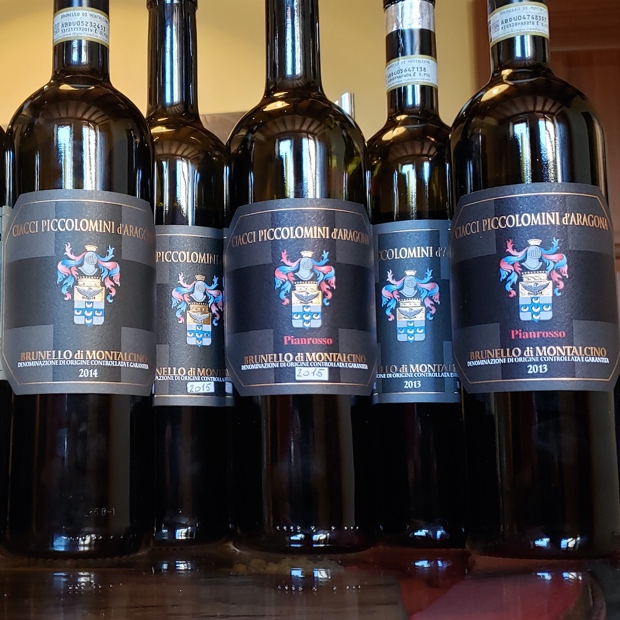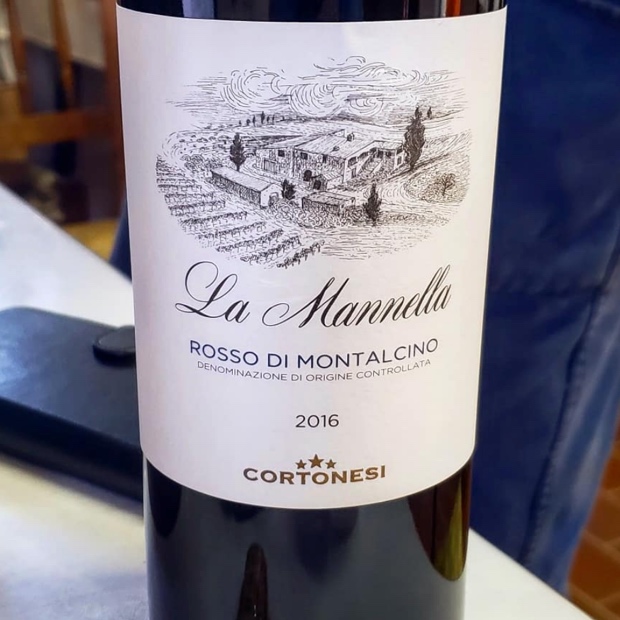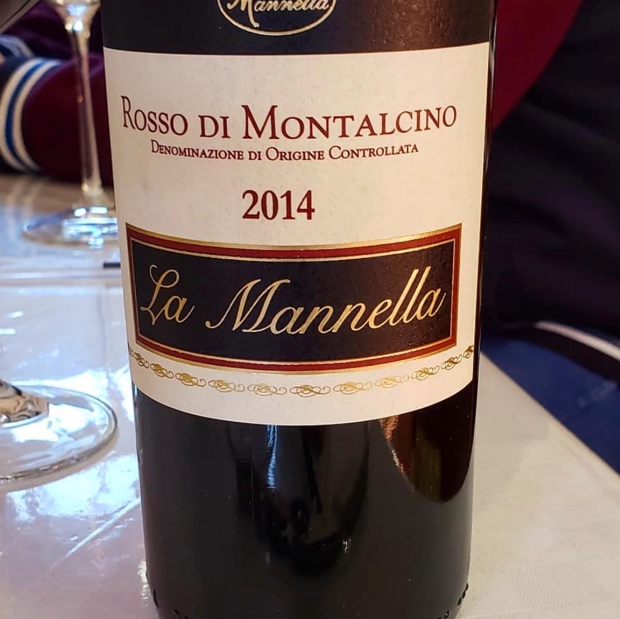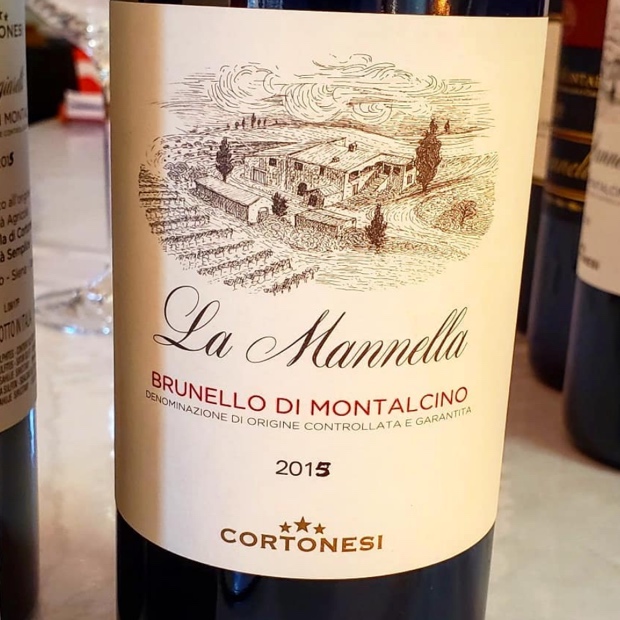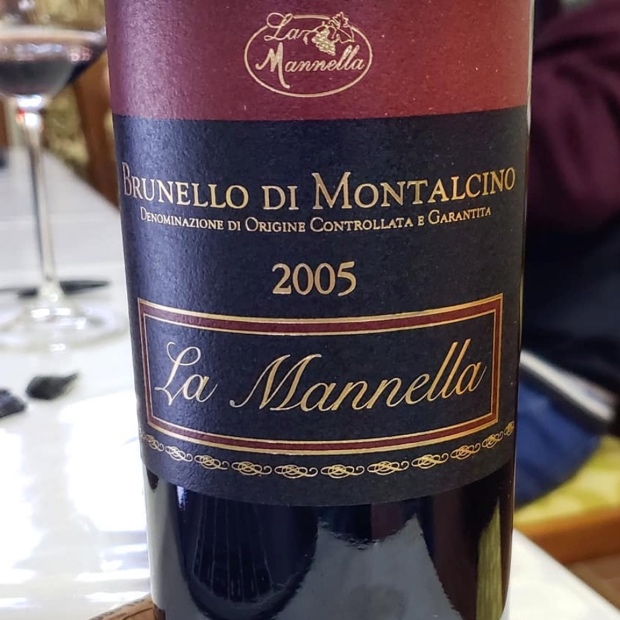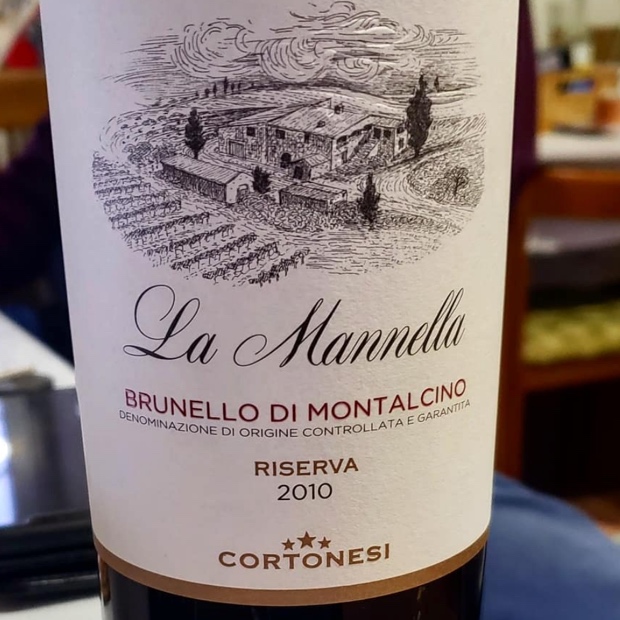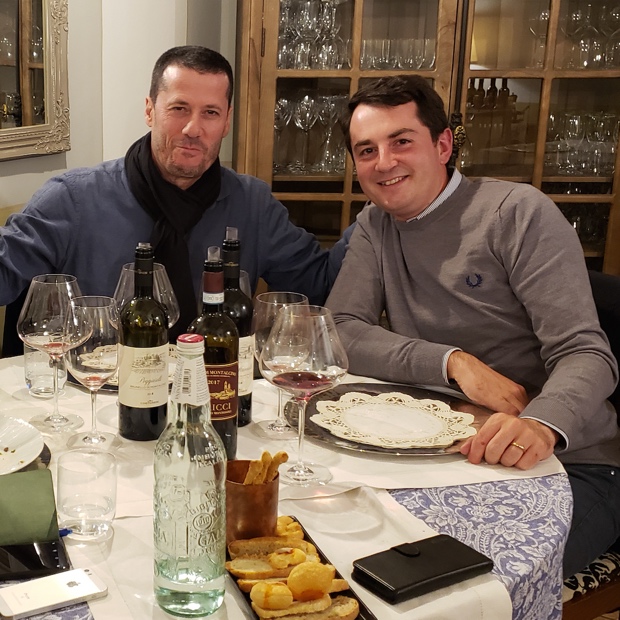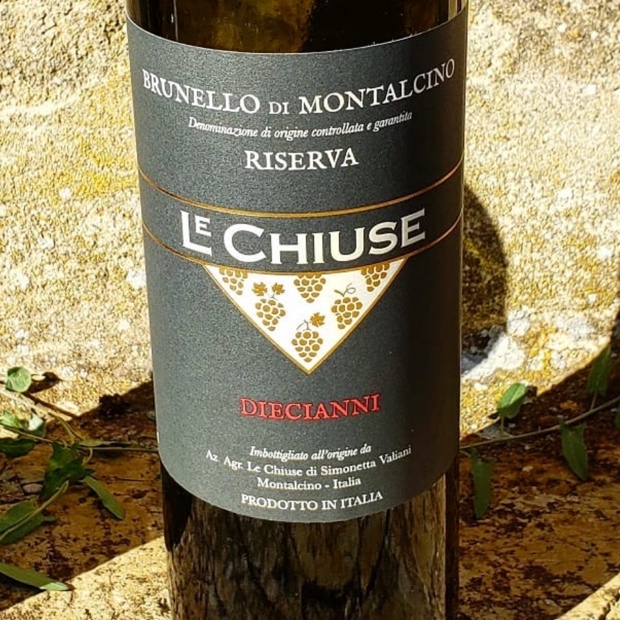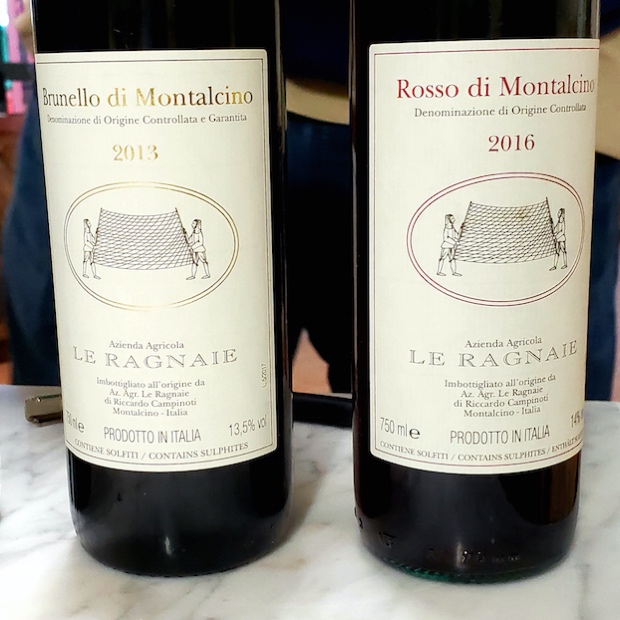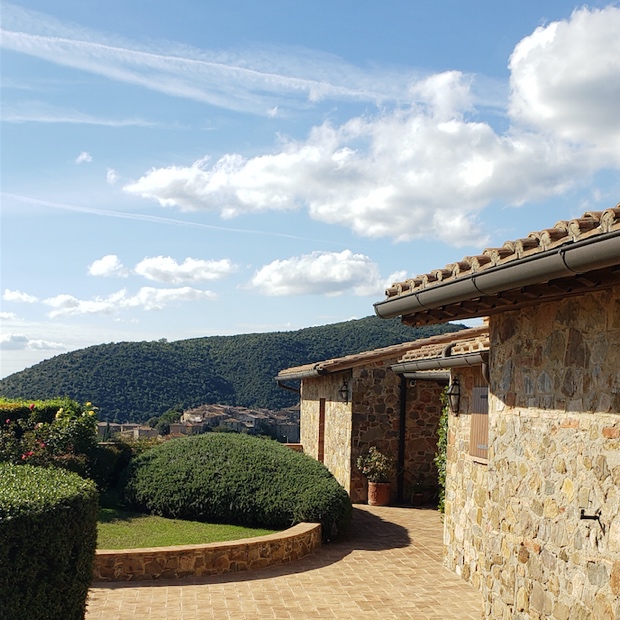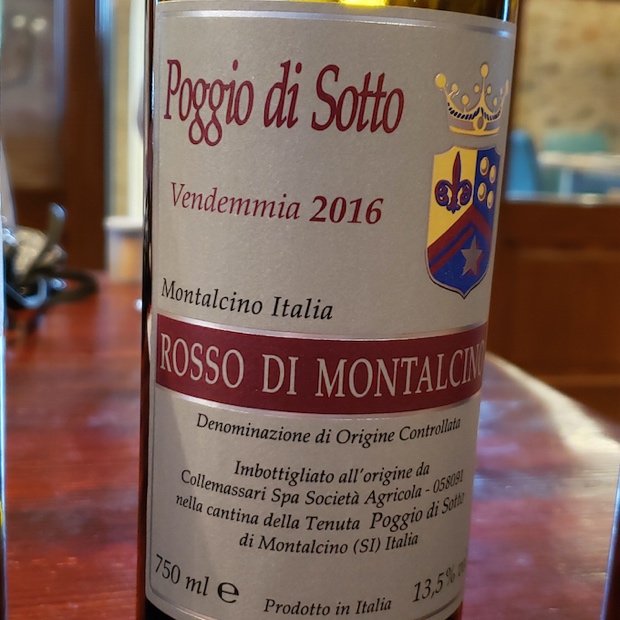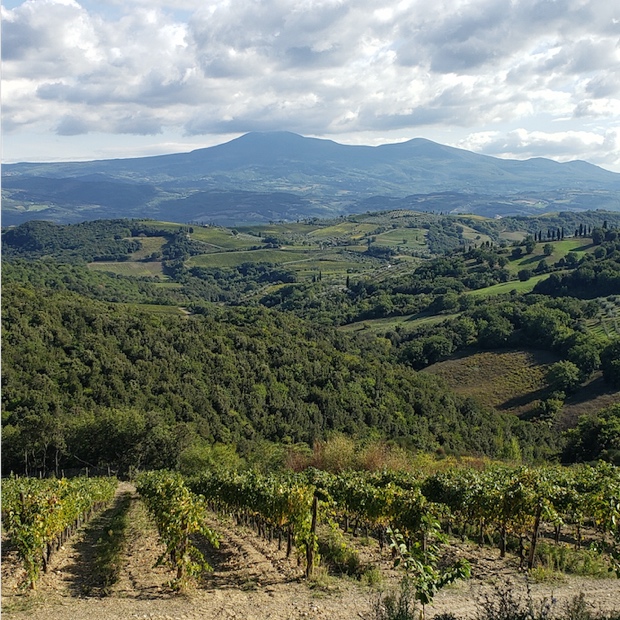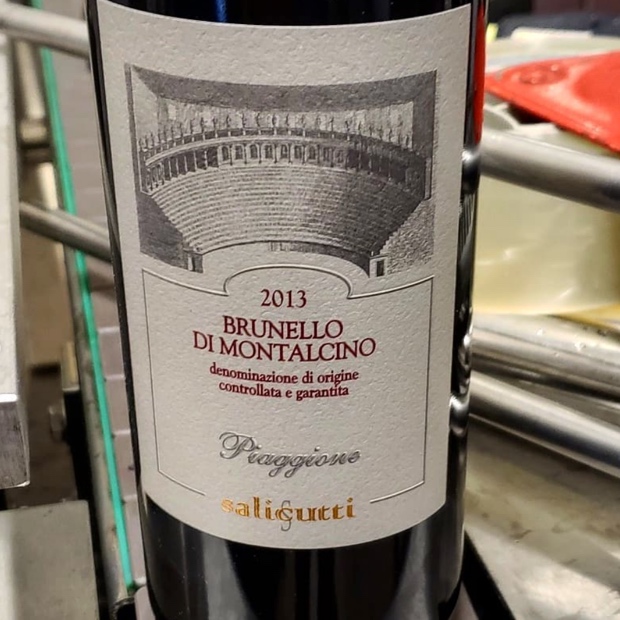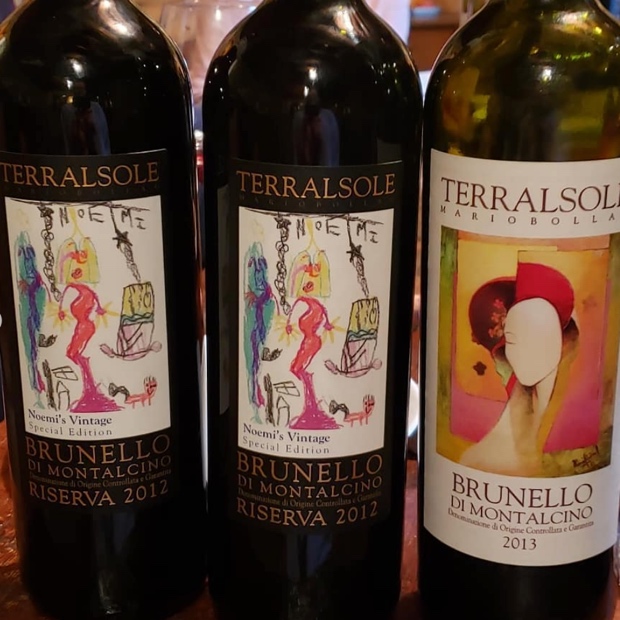On June’s busy calendar a fast and intense 36-hour window opened for a flash visit in Montalcino, too short yet one so worth the sidle. A great privilege it was to attend the Consorzio Vino Brunello di Montalcino’s new Rosso event called “Red Montalcino.” In November of 2021 the decision was made to migrate away from the larger event of Anteprime di Toscane and with the launch of Red Montalcino the full division has now been made. Simply Red for Rosso, solo artist now, with Brunello di Montalcino’s Benvenuto event returning again this coming November.
Hours well spent with home away from home Il Giglio family, two masterclasses in the Chiesa di Sant’Agostino and a walk-around in the Chiostro Museo Montalcino. A fascinating retrospective look back at 10 years of Rosso di Montalcino in masterclass number one titled Dieci Anni di Rosso di Montalcino. Longevity and the subtleties in secondary characteristics came of age through the lens of eight stellar examples. Masterclass number two called Selezione di Rosso di Montalcino brought the idea of “cru” or “selection” to light for a DOC appellation of ever increasing importance. Vino Sapori e Inspirazioni Nel Cuore Di Montalcino is a sentiment that refers to so much more than just flavours. Rosso di Montalcino defines the new profound in Italian wine.
On arrival there was a hop into Violante Gardini Cinelli Colombini’s car for a three-hour tour of Casato Prime Donne, a first and finally crossed off bucket list visit. The two night, one day sojourn culminated with an energizing Red Montalcino gala under the stars in the Fortezza di Montalcino where Lara Gilmore and Food for Soul Italia brought innovation and zero waste food execution to Toscana.
Related – A visit with Violante Gardini Cinelli Colombini
The 2020 Rosso di Montalcino vintage is best described as one of blanketing and nurturing, a child of a warm and dry season, devilishly if dangerously low in quantity and one in Rosso terms to envision as lasting for a very long time. There was less disease pressure and the plants just knew what to do. Also great temperature fluctuations, seemingly all through harvest to allow the complex development of aromatics with increasing intensity. This application is becoming an annual occurrence, a positive attribute of climate change, if you will. A season gifting viscosity and that deepest of red cherry fruit.
The vintage gains importance because 2020 holds both joy and also grip. Many estates only produced 20-30 per cent as compared to 2019 but surely a number as a factor of the average, norm or potential. Adversity and low yields aside the purity is unrivalled for Rosso, the liveliness too, before transitioning to true sanguine sangiovese coursing through. The dichotomy by way of a 2020 Rosso comes from swelling fruit and aching acids through tannins sweet and unsurprisingly supportive. At its best it is like discovering the first ever vintage of something profound.
As for 2019, notes from the November 2021 Benvenuto and those tasted this past June transcribed below will tell a story of a vintage out of which quality is right up there with quantity. A season of purity and clarity, what Rosso should be. An exacting transcript of terroir, a mirror held up to località; profumato, sfumato, evocativo…the essence of the land. For a Godello primer on the most fascinating aspects about Rosso di Montalcino, please read on ahead.
Related – What the winemakers drink: Rosso di Montalcino
In the Godello article about Benvenuto Brunello 2021 the phrase “Much ado and what to do about Rosso di Montalcino” began a quest towards seeing the changes and more importantly the future of the appellation. As a reminder, “culturally speaking Rosso di Montalcino is the most important wine. It’s what the Montalcinese drink daily. More than one Montalcino winemaker has used the phrase “it’s what we like to drink” and just as many will tell you that Rosso must reflect sangiovese’s character more than any other wine. What we know is that the Rosso are the protagonists of the new market.” The attitude prevails. “Rosso di Montalcino could and should be elevated to DOCG status. To do so requires investment and also a mandatory minimum aging period in wood. More vineyards need to be designated as Rosso and were a DOCG awarded the rules would need to be altered to make sure the wines are pre-declared as such. There is enough Brunello to go around and the world needs more Rosso di Montalcino.”
Related – Montalcino Previews: 2020 and 2019 Rosso, 2017 Brunello Annata, Vigna and 2016 Riserva DOCG
Tasting Rosso di Montalcino over the course of two days in June proved with unequivocal doubt that quality across the board has never been greater or higher. This assessment is based on three crucial criteria; first are the guarantees of character and calibre in the two most recent vintages, they being 2020 and 2019; then there is the accordant longevity of both Selezione Rosso but also 2010s decade wines as noted through examples poured at the morning session in the church of Sant’Agostino. Here are the notes on the 44 Rosso di Montalcino tasted on June 10th and 11th, 2022.
Dieci Anni di Rosso di Montalcino (Ten Years of Rosso di Montalcino)
Il Poggione Rosso Di Montalcino DOC 2010
Truth straight and inherent from a Rosso nearly 12 years of age, fresh and immovable. Speaks the structure of a vintage, even for Rosso, were it crafted in this way and equipped to speak on behalf of sangiovese’s age-ability, no matter the what, where and why of the fruit. Camphor oil, anchovy and a melange of “salato” umami to speak of Sant’Angelo in Colle and then, all of Montalcino. Beautiful wine with a long, liquid chalky finish. Drink 2022-2024. Tasted June 2022
Pietroso Rosso Di Montalcino DOC 2011
Less grip and hold then 2010 and were it tasted here, also 2012 as well. This Rosso has moved into next level and territorial existence, now porcini and tobacco, frutta di bosco and all the earth, mulch and woods once waiting in the wings. Showing as a wise and well-aged Rosso that has seen its best days though drinks with sweet savoury clarity in the here and now. Drink 2022. Tasted June 2022
Le Chiuse Rosso Di Montalcino DOC 2013
From the producer, that being Lorenzo Magnelli, man who looks to the largest berries for his Rosso di Montalcino. The great surprise that is 2013 sangiovese from Montalcino resides in a glass like this, evolving yet holding its line with great acumen. The northern side of the village surely aids and abets in extending the life of Rosso. Hard to believe the beauty inherent and the elasticity of this fruit. Suave, assured and holding all the cards to keep on keeping on. Drink 2022-2026. Tasted June 2022
Canalicchio Di Sopra Rosso Di Montalcino DOC 2015
The Rosso ’15 from Francesco Rippacioli is not what should be called immovable or formidable yet there is some depth and even brood to its dark back cherry constitution. Rich and certainly the sort of sangiovese that leaves an impression, a mark and a depression on one’s palate, but also heart. Keep and enjoy this Rosso for several years still ahead. Drink 2022-2026. Tasted June 2022
San Lorenzo Rosso Di Montalcino DOC 2016
The Annata 2016 is the most democratic and elongated of them all, that is with respect to recent times. In Rosso this means elasticity, stretched tannins and fruit made leathery, adhering to the structural organization like no other vintages come earlier or soon to follow. San Lorenzo’s shows chewy fruit, part plum, part persimmon, part liquorice and also a pod aspect, like bokser as an example. Acids are along for the ride and chalkiness in not exactly sweet tannin persists. A Rosso in several parts, linear above all else, all of them interesting. Drink 2022-2024. Tasted June 2022
Ridolfi Rosso Di Montalcino DOC 2018
Of lithe structure and fading light, a Rosso in descending denouement, trailing fruit and acids as it falls behind the horizon. Lovely in its maturity though the stuffing was not there to support more than a few years of flesh and depth. Drink up. Drink 2022. Tasted June 2022
Poggio Di Sotto Rosso Di Montalcino DOC 2019
From 2019 Rosso rests in a red fruit Poggio di Sotto vacuum, surrounded by walls of structure to maintain a vintage exaggeration, which is in fact what their Rosso style is consistently all about. Upon further examination the fruit is found to exists in a state of both precocious maturity and one that will hold for years. Understanding arrived early and yet there will be no great hurry to move forward with any great haste. A wise Rosso with some swagger and confidence. Drink 2022-2026. Tasted June 2022
Argiano Rosso Di Montalcino DOC 2020
Incomparable to the rest of this 10 years of Rosso di Montalcino flight. Raw, emotion-filled and aromatic of florals, wood spice and new fabric scents. Complexity abounds with an almost graphite-creosote-fresh tobacco trilogy, unresolved, staid and secure. Truth of the sensation is pure Argiano, chewy, leathery, rich and yet clear, transparent and open-knit. Should get really interesting in three to four years. Drink 2023-2026. Tasted June 2022
Selezione di Rosso di Montalcino (Rosso di Montalcino Selection)
Fattoria Dei Barbi Rosso Di Montalcino DOC Selezione Colombini 2020
One whiff and Barbi it is, unequivocal, knowable of an ilk and administered idiom not to be denied. The scent of history and experience while perhaps not quite the democracy of say 2016, yet this Rosso 2020 comes eerily close. Purity of southerly red fruit picked and layered in equanimous fashion, confident and telling the breadth of a Barbi story. Lifted, rising weightless into high tonality. All this in the micro-vernacular of a selection made purposeful for the specificity of this cuvée. Drink 2023-2026. Tasted June 2022
Casanova Di Neri Rosso Di Montalcino DOC Giovanni Neri 2020
Named in light of proprietor Giacomo Neri’s son and produttore Giovanni. There are few Rosso as open, gregarious and generous as this 2020. Quando buono e buono, when it’s good, it’s good and that is what really matters in Neri’s Rosso Selezione. Round, circuitous, acids draughting fruit and tannin trailing acidity. Comes back to the beginning and starts the process all over again, on repeat. Humility and classicism are in this Rosso, which seems to make perfect sense. Wood needs to integrate before the best days arrive. Drink 2023-2027. Tasted June 2022
Col d’Orcia Rosso Di Montalcino DOC Banditella 2019
There seems to be a trend forming with respect to Rosso Selezione because this by Col d’Orcia is so very eponymous and must be regarded as aching in notation of the estate and place from where it comes. The scents, of fruit blossoms, bosco and sweet tobacco link Banditella with Rosso and Brunello. In this sense Selezione is neither but instead the bridge connecting sangiovese to both. If that is the point then Col d’Orcia is a builder of relationships and new traditions. More barrel felt upon the finish, also the sharpness of yet to fully integrate acids and so with patience allow for a coming together. Can guarantee this will drink well in 2030. Drink 2024-2030. Tasted June 2022
Ciacci Piccolomini d’Aragona Rosso Di Montalcino DOC Rossofonte 2019
From 33 year-old vines, more barrel than some other Rosso Selezione and thus the link is closer to Brunello than Rosso. Noting tobacco smoulder, brown butter, toasted nuts and vanilla, strong wafts that confirm the suspicion. A full and creamy Rosso is the result, classic for the lineage and highly representative of the house style. Needs another year for secondary notes to come out and replace some of the cloud cover created by the wood. Drink 2023-2025. Tasted June 2022
Il Marroneto Rosso Di Montalcino DOC Jacopo 2019
And now for something completely different. Aromas unlike any other Rosso Selezione in the flight, more fight than flee, that much is known and free. An intensity of spice, east and west, the full indy or monty, tied together by a vivid set of fruit on top. Might feel like a big Rosso, a.k.a Brunello but the truth is Jacopo is just a bit more grown up, ambitious and steadfast in conviction than many others. Expresses 2019 with utmost flesh, fruit (including blood orange) showing a slight mature to transformative edge. Great grip will send this further so that density and compactness can melt away. Drink 2023-2027. Tasted June 2022
Caparzo Rosso Di Montalcino DOC La Caduta 2017
Once again the gears are changed, the climate and soils alter, the aromas deliver what the first five Selezione had not in this Rosso flight of eight. Quite fine, very mineral and surely the Rosso child of true Galestro terroir. Also warm and developed yet kept in check by northerly attitude, making things straight and right out of 2017. The affinity with La Casa (Brunello) seems obvious, with the stones and the slope bearing similar fruit. Showing some age and peppery heat but perfectly in the window right now. Drink 2022-2024. Tasted June 2022
Fattoria Del Pino Rosso Di Montalcino DOC Il Jeccardo 2016
The conspiring factors are all quality ones to bring Fattoria del Pino’s Rosso into fine current form. The gift of vintage, the concept of Selezione and the block party that is Il Jeccardo. The soils are schist-marl (Galtesro), calcareous and sandy (Arenaria) for one of Montalcino’s most diverse. Brings the amenities for Rosso that are crushable, elegant and structured. These are all present in FdP’s 2016, accounting for and representative of the soil conglomerate that makes this a wine both special and humble. A joy to drink. Drink 2022-2027. Tasted June 2022
Franco Pacenti Rosso Di Montalcino DOC Gemma 2015
Travelling back six-plus years for Rosso may have been an exercise once only reserved for a select few but the pastime is now a normal and oft repeated vocation. Franco Pacenti has captured 2015’s generosity and fruit first commentary with great distinction and the Selezione Gemma is filled with copious aromatics. Moves into stone rolled linearity running right through the middle of a fleshy wine that speaks in a structural vernacular. What’s amazing is how this truly stands out as a complete wine in a flight for 2015-2020 as the only truly resolved and ready to justify the means. Individually or collectively, either or for both. Drink 2023-2026. Tasted June 2022
Simply Red: A Rosso di Montalcino walk-around tasting
Armilla Rosso Di Montalcino DOC 2020
Fine and classic if on the full and textured side, though nothing out of the ordinary as it pertains to the vintage. Does well to merge the rise of fruit into the structured spectrum. All fruit and spirit, a side show of acids and those tannins which support in full cohort. Does 2020’s warm and generous vintage proud. Drink 2022-2025. Tasted June 2022
Canalicchio Di Sopra Rosso Di Montalcino DOC 2020
Call this Rosso balanced, even if what emits is not quite the same the equanimity of 2019. Still there is nurturing from out of the blanketing warmth of 2020, a linear progression from grippy fruit through acid succulence. The construct of structural motion is more than just a notion and the wine is in constant flux, unsettled, not having arrived anywhere near its final, or intended destination. Will move with the times, be transferable, able to reinvent itself time and time again. As a Canalicchio di Sopra it most certainly will. Bottled only three months ago so understand why there is so much speculation. Francesco Ripaccioli believes the evolution will be like 2016. Drink 2024-2029. Tasted June 2022
Capanna Rosso Di Montalcino DOC 2020
Fragrant and floral Rosso from violets to roses, liquid chalky out of the gate and poised to burst with fruit in the glass. A fine and approachable Rosso with just a minor verdant grip in urgency at the finish. Drink 2022-2024. Tasted June 2022
Caprili Rosso Di Montalcino DOC 2020
Must find common ground here with Giacomo Bartolommei in thinking this will be a very long lasting vintage in Rosso terms. Not a wine so knowable from the start per se but one of evolution, of gaining stature because of inherent structure. More than seven months since this would have first been shown and there is a renewed potential, fruit quality and substance in action on a current high, estimably positive and representative of this ever-impressing estate. Grapes are chosen based on the differentiations of the vineyard, not de-classified from Brunello as in the past. Yet the elévage is similar, just shorter and crucial decisions are made after the first year. So good. Drink 2023-2028. Tasted June 2022
Cerbaia Rosso Di Montalcino DOC 2020
“To us Rosso di Montalcino is important because we take from the Brunello vineyards and in 2020 only 4,000 bottles were made, though Rosso is not produced in every year,” tells Elena Pellegrini. From the youngest vines out of a single plot planted in 2002. Decision making occurs during harvest and at least two or three passes are made. The potential is 30,000 at Cerbaia and so Rosso is a special wine, never an afterthought, always carefully considered. It shows in the restrained power, the elegant confidence, the nurturing and matriarchal presence. Again there is dichotomy by way of a 2020 Rosso, from swelling fruit and aching acids through tannins sweet and unsurprisingly supportive. Spent four months in Grandi Botti 25-50 hL and readiness is just ahead. Drink 2023-2026. Tasted June 2022
Collemattoni Rosso Di Montalcino DOC 2020
Spent 18 months in 30 hl Slavonian Botti, longer than many and only bottled four months ago. From two vineyards, one near the cellar in Sant Angelo in Colle and the other on the road to Castelnuovo dell’Abate. The latter brings the chalky mineral to compliment Colle’s fruit and fleshy power. A push-pull Rosso, from sweet youth to rocks and sand of grit and fine-grained tannin. Persistence is a key factor and that classic Collemattoni red Rosso signalling all the way through. Will come together after another winter. Drink 2023-2026. Tasted June 2022
Corte Dei Venti Rosso Di Montalcino DOC 2020
Perfectly dusty like dried roses, pressed and petals crumbling. Potpourri fragrant and a clarity expressive of 2020, like discovering the first ever vintage of something profound. When Rosso has lift it acts just like this and yet there is some weight though also a weightlessness about the way it’s always rising. In that regard it should be chocked up to the concept of restrained power. Great showing. Drink 2023-2027. Tasted June 2022
Cortonesi La Mannella Rosso Di Montalcino DOC 2020
Rosso di Montalcino is the child of a warm and dry season of which incidentally Tommaso Cortonesi is a big fan. Less disease pressure and a vintage where the plants just “knew what to do.” Also great temperature fluctuations, seemingly all through harvest to allow the complex development of aromatics with increasing intensity. This application is becoming an annual occurrence, a positive attribute of climate change, if you will. Cortonesi has been increasing aging times over the past 15 years from six to 12 and now nearly 15 months, spending botti time (20 per cent new) for 14 out of 2020. Top edging fruit and edgy accents elevate the aromatics so that the terroir is allowed to shine on through. Behold this prime work ethic, use of wood and also time in all the right ways. Place is at the fore. Grande. Drink 2023-2028. Tasted June 2022
Donatella Cinelli Colombini Rosso Di Montalcino DOC Casato Prime Donne 2020
“We need to explain that this is a wine that is very different than the Brunello and during the harvest we decide which grapes will be for Rosso and for Brunello.” The words of Violante Gardini introduce a wine that respects nature in a very specific vintage, made for freshness, fun and not as a baby Brunello. “Otherwise it will be a disaster. It must have identity, to show this wine in a different way.” The vintage gains importance 2020 because 2020 holds both joy and also grip. It does not try too hard, nor is it asked to do too much. Extraction is low, oak usage big, in botti. Donatella would like the consumer to drink this young but this vintage will do well for a minimum three plus years. Drink 2022-2026. Tasted June 2022
Fanti Rosso Di Montalcino DOC 2020
Fanti grows 15 hectares for Rosso for a potential of 120,000 bottles though only 50,000 were made from 2020. Ages for a year in big barrels plus some fourth passage barriques. As a rule this is a classic vintage, very different than 2019 and bottling happened in January. Another ilk, other worldly, no way to mix this season into the memories of any other. Fanti’s Rosso takes ownership, even at this stage just five months in, a standout to be counted 2020. Balance and execution are what brings it to this. Drink 2023-2026. Tasted June 2022
Fattoria Dei Barbi Rosso Di Montalcino DOC 2020
Now sweetly and juicily fruit forward, if a bit out of character as such. This is the “normale” Rosso (as opposed to the Selezione Colombini) and so elévage is just six months in wood. All in the name of approachability and amenability, perhaps the most ever, or a new chapter in Barbi Rosso. For the people, fresh as a rule, democratic. Last tasted June 2022
A vintage of viscosity and deepest of red cherry fruit, off of vines five to fifteen years old. While really young there is access here for drinking a 2020 ahead of many others. Classically dark Barbi fruit and a Galestro feeling. Bottled just less than one month ago and settled into a calm state by now. Will remain stable for a few years, not necessarily gaining in complexity but surely keeping on. Drink 2022-2025. Tasted November 2021
Fossacolle Rosso Di Montalcino DOC 2020
Rosso sees 10 months in Botti (25 hL or less) plus some time in concrete. Selection is from young vines though as they age that availability lessens and so some barrel selection is necessary to be part of the mix. Makes decisions more difficult, having to include some barriques in Rosso. An underdog vintage things Stefano Bambagioni, one out of which after 12-18 months something magical will begin to happen. All this to say that Rosso is “something that is alive,” and balance is the ultimate goal, as witnessed here, in the result. Smooth as silk, of sweet tannins and clear as present danger of a potential for aging. Five to seven years easy. Drink 2023-2027. Tasted June 2022
Le Chiuse Rosso Di Montalcino DOC 2020
The finest sangiovese grain and naturally occurring sweetness come from Lorenzo Magnelli’s 2020 Rosso, a varietal humectant of such pleasing mouthfeel to reside at the top of the region’s ever-improving appellative echelon. Few Rosso are able to achieve this ilk of floating nirvana, where once its largest of berries macerated towards fermentation in great solicitation of emotive capability. It all makes cause to pause and reflect. Really succulent and also architectural, a construct of stone, bone, acid and karst, vertical, linear, moving forward and winning. Drink 2024-2030. Tasted June 2022
La Lecciaia Rosso Di Montalcino DOC 2020
Seemingly night versus day in contrast with the soft and resolved 2018 but time is likely the reason. The force is felt immediately on the nose, not exactly hot but surely grippy, agitative and a bit bothered. A matter of early circumstance, the reason to exercise patience and wood in charge an unavoidable result of all these matters. Re-visit in 2024. Drink 2024-2028. Tasted June 2022
La Màgia Rosso Di Montalcino DOC 2020
Quite a dense mat and full mess of fruit for 2020, magnanimous, fulsome, fully set glycerin and pectin. There is balance despite the nearly jammy constitution as a by-product of the vintage. Raised at elevation (500m) in the southeast of Montalcino. From 15 hectares, all Brunello capable and in fact the affinity here is with the bigger wines with only elévage separating the Rosso. Prepares us for what the Grand Vin will be like as it pertains to this specific vintage. Drink 2024-2028. Tasted June 2022
Lisini Rosso Di Montalcino DOC 2020
Yet another archetypal 2020 Rosso, fragrantly perfumed to the calcareous hilt and also notably structured from all points leading out from go. Feeling a true mineral streak running through, elevating cherries in season, juicy and fleshy, ripe and fully formed. Well made, balanced and truly essential Rosso work. Drink 2022-2025. Tasted June 2022
Piancornello Rosso Di Montalcino DOC 2020
Somewhat reductive though the fruit set is magnified and of a clarity in black cherry, followed by a waft of tobacco. Works the glass with credibly strong and accountably forceful tannin. In a Brunello vein, there is lots of wine here. Drink 2023-2026. Tasted June 2022
Pietroso Rosso Di Montalcino DOC 2020
A selection is made from all grapes coming in for 17,000 bottles of Rosso out of 2020. Ages one year in a combination of botti and tonneaux, from the start showing great promise. A warm vintage and it shows. Mainly Galestro, a stony soil that comes through in the combination of glycerol and chalkiness. Not gravelly but a sandy-stony feeling gained, of smooth grain, easily transferred over the palate and sweetly endowed with acid and tannin. Another star rising to the top of the Montalcino pantheon. Drink 2023-2028. Tasted June 2022
Talenti Rosso Di Montalcino DOC 2020
Heady, big-boned, exemplary of combing and combining two terroirs’ contribution to layer Rosso di Montalcino. The ripeness of 2020 fruit is at appellative peak, tightening further, compact, compressed and staid. For now and with two years further the fleshy juiciness will surely emerge. 25,000 bottles produced. Last tasted June 2022
Tight, young and early bracing Rosso from Talenti, showing off the darker fruit of the vintage and surely offering a glimpse into what the Brunello will bring three further years down the road. A vintage of well developed fruit and sharp acidity, vividly captured in a sangiovese just like this. Drink 2022-2026. Tasted November 2021
Tenuta Buon Tempo Rosso Di Montalcino DOC 2020
Just bottled two months ago, fermented spontaneously in steel, aged primarily in cement with a short stay in Slavonian oak. A late frost resulted in only 8,000 bottles being produced (as opposed to 55,000 in 2019) so hang on to these precious gems from rare Montalcinese alluvial soil just above the canyon of the Orcia River. Adversity and low yields aside the purity is unrivalled for Rosso, the liveliness too, before transitioning to true sanguine sangiovese coursing through. So right and proper, vanguard and directly linear for Rosso. Needs two years settling time. Treat this like a category within a category, or just as one on its own. It could be said that 2020 is like proprietor Filippo Bellini, a case of half and half. Drink 2024-2028. Tasted June 2022
Ucceliera Rosso Di Montalcino DOC 2020
Along with Voliero the Rosso at the hands of Andrea Cortonesi is one of agriculture, above all else. If the term may be used this way then Ucceliera is Riserva to Voliero’s Annata. Here the compactness of earth on fruit is layered, beginning with the strata below and culminating in the fruit above. Does indeed need to unwind, shed tannin and terroir while staying focused and in its contiguous state of meditation over agitation. This it will. Last tasted June 2022
A Rosso further along than many, at least in terms of fermentative culmination and post-shock living. Shows off the hue and depth of vintage fruit with more redness, cherry ingress and tannic redress. You can feel the grip and the controlled power in this sangiovese. Will be a very good one because it already is. Drink 2022-2026. Tasted November 2021
Voliero Rosso Di Montalcino DOC 2020
Farming, farming, farming. When Rosso come across this way, profumato, sfumato, evocativo…it is the essence of the land. Southerly Montalcino at elevation, taut, persuasive and meaningful, a seamless sangiovese missive. For Rosso, what is just, necessary and right. Last tasted June 2022
Tight, taut, wound around itself like a wire around a spool and yet having found its way out of fermentation and through bottling. Less fruit than brother Ucceliera and also lower toned, earthbound, grounded and yet the acids are right on point. Drink 2022-2024. Tasted November 2021
Col Di Lamo Rosso Di Montalcino DOC 2019
“A little Brunello, so we prefer more time,” tells Giovanna Neri. Spends eight to 10 months in large Botti, plus 10 per cent in tonneaux and barriques. Then two further years in bottle. Vineyards are on the road that connects Buonconvento with san Quirico. Still a touch reductive, of liquorice and spice, fennel and salumi. From sandy clay soil in a Rosso of intense hue but also texture. All red fruit with balsamic seasoning in a very specific Rosso style. Drink 2022-2025. Tasted June 2022
Franco Pacenti Rosso Di Montalcino DOC 2019
Rosso sees a year in 25 hL botti, the fruit coming from 10 hectares of vineyards with the youngest vines now 20 years of age. On average Rosso makes up 8,000-10,000 bottles of the total production. Here from 2019 purity and clarity, what Rosso should be. An exacting transcript of terroir, Località Canalicchio di Sopra snapshot of place and most importantly a right here, right now transcribing of vintage. Crisp and crunchy, of fine acids, easy and yet sneaky of structure, so very well composed. Always a pleasure to taste with Lorenzo Pacenti. Drink 2022-2026. Tasted June 2022
Mastrojanni Rosso Di Montalcino DOC 2019
Still tight and terroir driven, that much is clear. Fragrant inclusive of earth and smoulder, woodsy in that aromatic way. Settling in just now yet quite structured and savoury for ’19 Rosso. Persistent, not of buzzing energy but surely from a place. Rosso as Rosso. Last tasted June 2020
Firm yet a Rosso with more than ample charm and grace, full red fruit and tannin interposed, layered and sharing the sangiovese stage. Takes some time but the fulsome and dusty work here really gains and makes haste of your senses. Takes hold and really does not let go. Drink 2021-2024. Tasted November 2021
Tenuta Buon Tempo Rosso Di Montalcino DOC 2019
As mentioned in the 2020 note there are 55,000 bottles of this 2019 (as opposed to 8,000 for 2020) and yet quality is right up there with quantity. Balance arrives without adversity after an elévage “sensa” concrete, only Slavonian cask, or as it is said, “tronco conico,” 64 hL. An aromatic Rosso, so bloody ripe, arrived at nirvana with a sense of place intact, that being Podere Oliveto. From 2019 Rosso is defined by democracy and generosity. Last tasted June 2022
For Alberto Machetti a similar and equally “cool” vintage with grapes in Castelnuovo facing Monte Amiata. Picking started on the 16th of September in a vintage with great freshness and in this case an intense level of savour. From the seven lowest hectares on alluvial clay soil only 50 metres from the Orcia River. Of double density and yields which work best for Rosso. Fine but relative ease and linear concentration for an easy but more than notable substantial essay of Rosso. Purple fruit and proper acids. Drink 2021-2024. Tasted November 2021
La Lecciaia Rosso Di Montalcino DOC 2018
This ’18 is the current vintage because La Lecciaia chooses to hold their Rosso back in even years. The 2020 will release in November. All done up in 25-35 hL botti for a minimum six to eight months, often up to a year. “For us we need more time,” tells Alessandra Pacini. Rosso 2020 is warm and nurturing, a cross of sangiovese and cask, silky of texture, soft, juicy and also peppery. Fine and never cumbersome, unencumbered because of time gone by. Sweet tannins, fine acids, nicely done. Showing at peak. Drink 2022-2025. Tasted June 2022
Good to go!
godello
Twitter: @mgodello
Instagram: mgodello
